SOUTH WEST ART NOW 2022





Bunbury Regional Art Gallery is once again excited and privileged to be able to present South West Art Now. First held in 1987, when the gallery opened, this exhibition is now a biennial survey of new and recent artworks by artists who live and work in the south west corner of Western Australia.
SWAN 2022 reveals stories about personal, local and global concerns, its communities, landscapes and snapshots of the current Zeitgeist, through the eyes of some of its most engaged observers – artists. Through their work, they make ideas and conversations about contemporary issues accessible, stimulating and moving, lending their insight to expressions of time and place.
I invite you to immerse yourself in this exhibition, to accept the challenge it offers to consider the world we live in today.
On behalf of Bunbury Regional Art Gallery, I would like to thank all those who have provided funding and assistance to this exhibition and associated programs.
The success of this exhibition, however, rests with the efforts of the artists and the curator Dr Diana McGirr. Her curatorial and analytical skills were put to the test, when almost 150 applications to participate were received for South West Art Now 2022. Fifty-five artists, including two collaborations, were selected and available to exhibit in this year’s show, which will fill three gallery spaces (Chapel, Lower and City) plus the Archive Room.
Many thanks go to BRAG’s staff and all other parties involved, for their professionalism and expertise in bringing this exhibition to fruition.
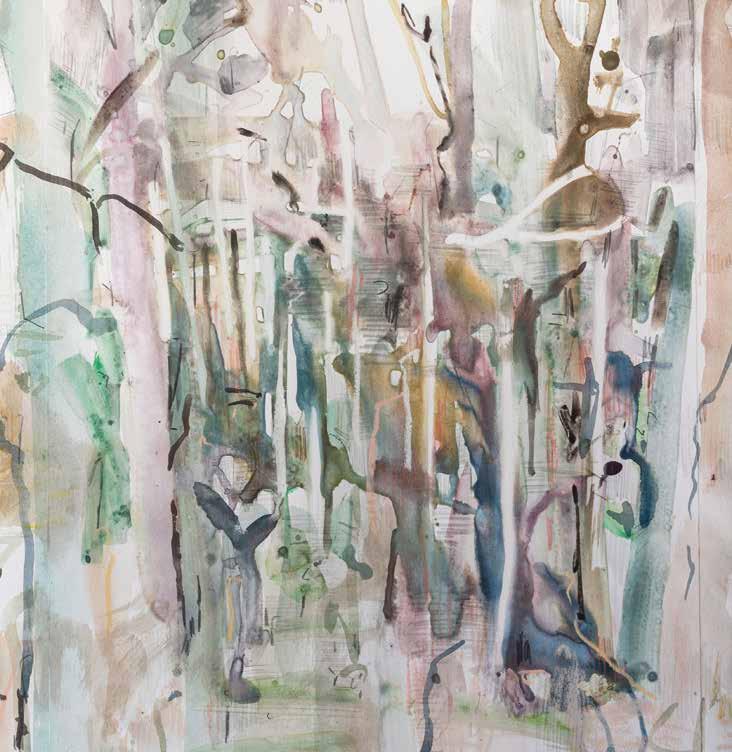
Landmark exhibitions play a vital role in the endorsement of contemporary art and artists. As a ‘spectacle’ with its own personality, South West Art Now offers artists a recurring opportunity for exposure and recognition in a prestigious exhibition, the potential of representation in a reputable public collection, the possibility of financial reward, and evidence of their involvement in a publication. The significance of this event is signalled by its longevity.
Formerly an annual exhibition known as the South West Survey, South West Art Now is a biennial survey of new and recent work by artists who live in the south west corner of Western Australia – an area stretching from Mandurah to Albany that covers the Peel, Great Southern and Wheatbelt regions as well as the South West.
The South West Survey grew out of a small scale exhibition devised by Bunbury Arts Council in 1980. The foundation of Bunbury Regional Art Gallery in 1987 created an incentive to re-vamp this event and the South West Arts and Crafts Festival Invitation Exhibition was launched. Renamed the South West Survey in 1988, within three years the annual showcase of contemporary art and craft was a feature on the regional arts calendar, indicated by the outcry over its absence in 1990. 1
By 1991 the Survey had become an open invitation exhibition, providing an opportunity for established and emerging practitioners to gain exposure and enhance their reputation. Although the number of entries received and works selected fluctuated annually, little changed with the shape of the Survey for a number of years. The Gallery’s flagship event continued to showcase the ‘breadth and depth of the region’s artistic talent’ and play a significant role in its cultural life, attracting visitors from all over the South West and beyond.2
In 1996, due to its growing popularity, a strict preselection process was introduced. With a focus on excellence in each medium, the works were chosen by Robert Bell curator of Craft and Design at the Art Gallery of WA. 3
The next significant change was moving the date of the exhibition from the winter months to February, to coincide with the anniversary of the Gallery opening on Valentine’s Day 1987. Consequently, there was no exhibition in 1999. But the change of date allowed the event to become a social occasion with music, food and wine; a potential launch pad for an annual cultural festival with the Survey as its centrepiece, to attract visitors from outside the region, providing even greater exposure for artists and performers. 4
Jo DarvallBoranup Forest (detail) 2022
watercolour monoprint on Arches
BFK with pastel and pencil triptych, each panel 73 × 92.6
image: Miles Noel
In 2010 the Gallery’s twenty–first birthday celebrations were viewed as a catalyst for change, by moving away from an open invitation to inviting an outsider’s perspective. 5 But apart from its formative years when the Director took responsibility, the selection process had always involved experts from elsewhere, and rumblings were already afoot within the arts community that change was needed.
In 2014 a decision was made to alternate the Survey with the Bunbury Biennale. Then in 2016 the suffix South West Art Now was adopted.
Essentially the Survey/South West Art Now is a manifestation of collective enterprise; invitations issued by the gallery, personal decisions made by artists, and the informed choices of individual curators and selection panels who decide who and what represents current trends in contemporary art and design. Its evolution reflects changed circumstances, the growth of the regional arts sector and a desire for something different from within the arts community. These changes are evident in particular in how the selection process influences the character of the exhibition. Who and what has been
 5. David Bromfield and Pippa Tandy, Over There: Survey 2010 Art in the South West (Perth: Brown Art Consultants)
5. David Bromfield and Pippa Tandy, Over There: Survey 2010 Art in the South West (Perth: Brown Art Consultants)
Who and what has been selected has always sparked passionate debate amongst artists and audiences alike.
selected has always sparked passionate debate amongst artists and audiences alike.

South West Art Now 2022 is a reflection of a progression from a broad-brush approach to curated selection. It’s not the first time I have been involved in selecting the Survey. In 2005, I performed this process with Galliano Fardin – Fardin as a respected artist and former Survey award-winner (1994) and me as the Gallery Director. He was drawn to work that demonstrated innovative and investigative use of materials and a ‘raw’ approach to medium and concept and showed great sensitivity towards each artist’s apparent intent. I recall him suggesting that regionally-based artists have greater freedom than metropolitan artists from following trends.
In the catalogue I wrote: ‘I know there will be work in the exhibition some people will question and perhaps even detest, but that is the nature and purpose of visual art. It is a medium for expression and debate. Year by year the Survey evolves and fluctuates. How dull if it were to become static and predictable.’6 This commentary illuminates my thoughts then and now.
An open invitation process ensured any artist who lives and works in the south west corner was eligible to submit an expression of interest for 2022. As an art historian, I was eager to explore the Survey ’s longevity by also inviting artists who had been involved in the early years to exhibit, along with some who have been associated with the exhibition over a considerable period of time, as well as a bunch of newcomers – emerging and established artists who have never participated: old faces, familiar faces and new faces selected on merit for the depth and quality of their practice regardless of medium or interests.
An aspect of the Survey/South West Art Now that remains constant is its avoidance of imposing a theme. This is something I feel strongly about, for I believe artists who are serious about their practice don’t need to be told what to do and the character of an exhibition emerges from their studios. Consequently, my intent was to design a compelling exhibition that reveals the high standard of innovative and imaginative work produced without any strings attached to the artists’ choice of subject, material or form.
Driving through the South West corner on studio visits, words and images swirled around in my head: who I had seen, what I had seen; why I found it stimulating to meet artists in situ and hear their stories about why they do what they do.

Mixed group shows can be fragmented. But despite the individuality of everyone’s practice and their eclectic mix of styles, subjects, materials and outlooks, I began to visualise the exhibition as a coherent ensemble. This may sound like a paradox, but allowing the character of South West Art Now 2022 to surface through its content enabled spontaneous connections to emerge. Amongst the divergent perspectives and myriad forms of art produced in these regional contexts, commonalities occurred without any need for a preconceived conceptual framework.
In ceramics, metalwork, glass, textiles, video, photography, drawing, printmaking, sculpture, installation; on wood, paper, canvas; with recycled and found objects, fifty–five artists investigate a horde of topical issues we face across the world in this troubled era, some driven by narrative, others focused on form, pattern, colour, process and materiality.
Issues such as the importance of home, family, community and belonging; climate change and the effects of human activities on fragile ecologies; corporate greed and consumerism; political satire and symbolism; a perpetual preoccupation with natural phenomena and landscape; the importance of culture and history; personal narratives; dislocation, isolation, introspection; explored with joy and longing, play and provocation.
Mixed group shows can be fragmented. But despite the individuality of everyone’s practice and their eclectic mix, I began to visualise the exhibition as a coherent ensemble.
For the 2004 Survey I wrote: ‘the artists appear to be preoccupied with a miscellany of subjects, but somehow amongst the universal topics of home, family and environment, a distinctive flavour emerges and the sense of locale becomes palpable.’ In 2005 I said : ‘ Irrespective of geography, it’s evident that we share universal fears and hopes for peace, the environment, humanity and our role in society. These general concerns become particular in the context of our locale and personal lives.’7
The Survey is no longer fixated on the nebulous idea of regional identity, but the artists’ enduring consideration of the universal and the particular shows that, in some respects, little has changed. Whilst art produced within the conditions of contemporaneity may be informed by regional positioning, South West Art Now 2022 illustrates it need not be constrained by it.
It also demonstrates the Gallery’s on-going commitment to an event that has captured the public imagination for thirty–five years. I would like to thank them for listening to my request to make more rooms available so that individual works can breathe in their own space whilst they create conversations with others. Thank you to everyone who has participated in the realisation of this exhibition and catalogue, and for sharing my vision.
Enjoy, ruminate, reflect, argue, like or dislike, agree or disagree – by doing so you engage with this show, its content and history, what it signifies, and the artists’ works.
By looking, listening and seeking, the audience will find connections and common ground, or not. Either way, the work speaks for itself.
Molly Coy
Pretty Plagues (detail) 2022
artist book: acrylic paint, ink, monoprinted archival tissues, frottage, coloured and gold foils
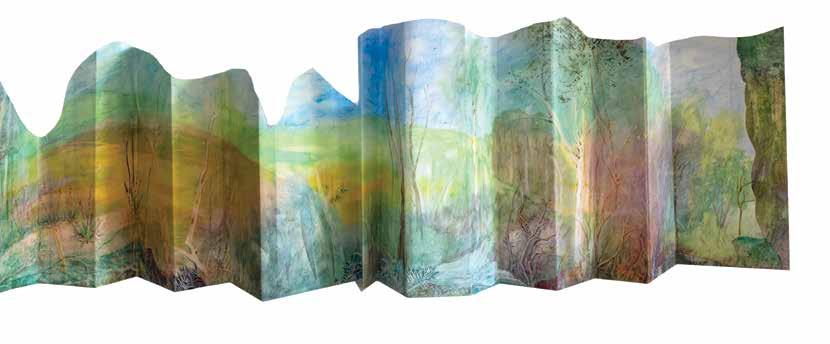
circa 62 × 450 × 50
image: Alan Coy
Dr Diana McGirr is an independent art historian-curator with an extensive professional background in collection, exhibition and gallery management, research and tertiary education, in the UK and Australia. She is a leading voice within the South West on contemporary art production in regional contexts.
Amanda Bell uses visual language to express her concerns and tell stories of betrayal and love, or in this instance death and the daily grind of work. Her intent is to invite consideration of the work itself rather than the maker.
It doesn’t sit easily with me or come naturally to express these stories in a written language. Frustration often arises from this task. AB
Amanda Bell is a Badimia (Yamatji) and Yued woman. Born on Whadjuk Country, she now lives and works in Goomburrup (Bunbury) on Wardandi Boodja. Bell experiments with a diverse range of materials and often incorporates audiovisual content in her work. She has exhibited in several group shows including Revealed at Fremantle Arts Centre and South West Art Now (2020). Her work is represented in the Art Gallery of WA collection.
Kedalak (Night): Oh, someone’s coming to get me (detail) 2022 clay, marri gum, teabags and stones dimensions variable image: Julian Bowron

Sam Broadhurst’s fascination with historic techniques grounds his practice in a considered and methodical approach to painting. For the past decade he has been researching the materials used by medieval and renaissance artists to gain insight into their methods. He uses this insight, coupled with his scientific knowledge, to devise recipes for purified walnut oil to give his paintings a particular luminosity and longevity. The versatile properties of the oil, made from walnuts sourced from the south west, allow him to move paint around in an almost sculptural manner, scrape back to raw canvas and shape his ideas, until he arrives at a point of expression that captures his perception of nature – a dialogue between artist and medium. Coupled with his scientific background, this knowledge enables him to use hand-made walnut oil in his process.
Painting is about connection and grounding. By making my own oil, I create a relationship with the materials that allows me to marry a medieval/ renaissance medium with a more contemporary application of palette knife. Painting is about my connection to the medium and the landscape, and bringing the two together on canvas. SB
After completing a Bachelor of Science at the University of Melbourne (1983), Sam Broadhurst worked in cancer research for a decade. In the late 1990s he developed an interest in painting and art history, which persuaded him to pursue his practice full-time when he moved to WA in 2001. He exhibits regularly, won People’s Choice in the South West Survey (2012) and was a finalist in the Lester Prize (2020).
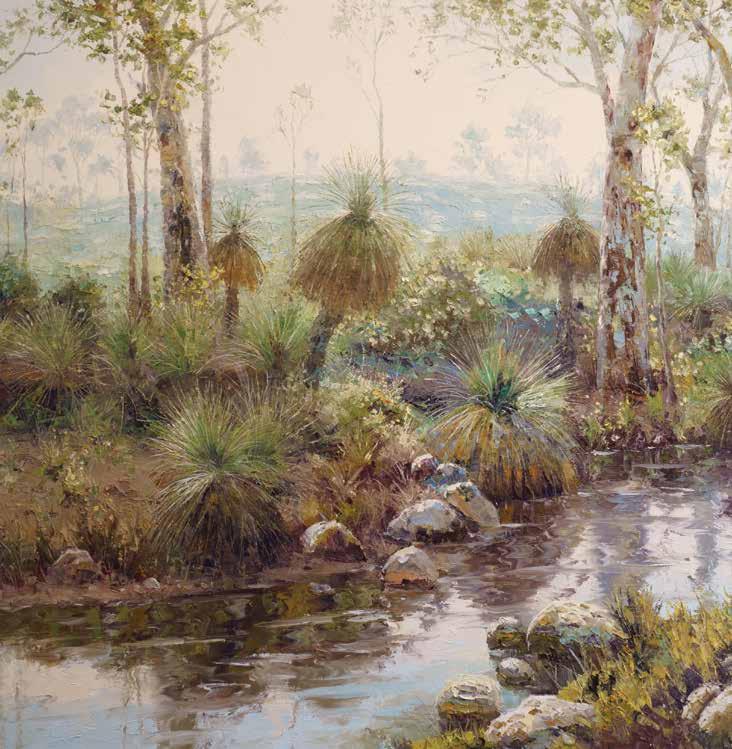
Characterised by a limited palette and subtle tonal shifts, Rachel Coad’s figurative paintings are often monumental in scale. Figuration offers a vehicle for Coad to delve into existentialism and the dynamic formed when viewer engages with subject. Conceived as a response to living in isolation
during WA’s COVID-19 border restrictions, her selfportrait The everything you don’t see is a comment about introspection and what you don’t see – the void around the image. Haunting and pensive, the intense gaze draws us into a moment of intimacy that invites us to linger and ponder.
In a career spanning twenty years, Rachel Coad’s reputation as a figurative painter of renown has escalated. She has been shortlisted for numerous awards including the Lester Art Prize – formerly the Black Swan Portrait Prize (winner 2016), Doug Moran National Portrait Prize, Kilgour Prize, Shirley Hannan National Portrait Prize, Bankwest Art Prize (People’s Choice 2014) and the Metro 5 Award. Her work is represented in many Australian and international collections.
The everything you don’t see, selfportrait (detail) 2022 oil on linen 63 × 83

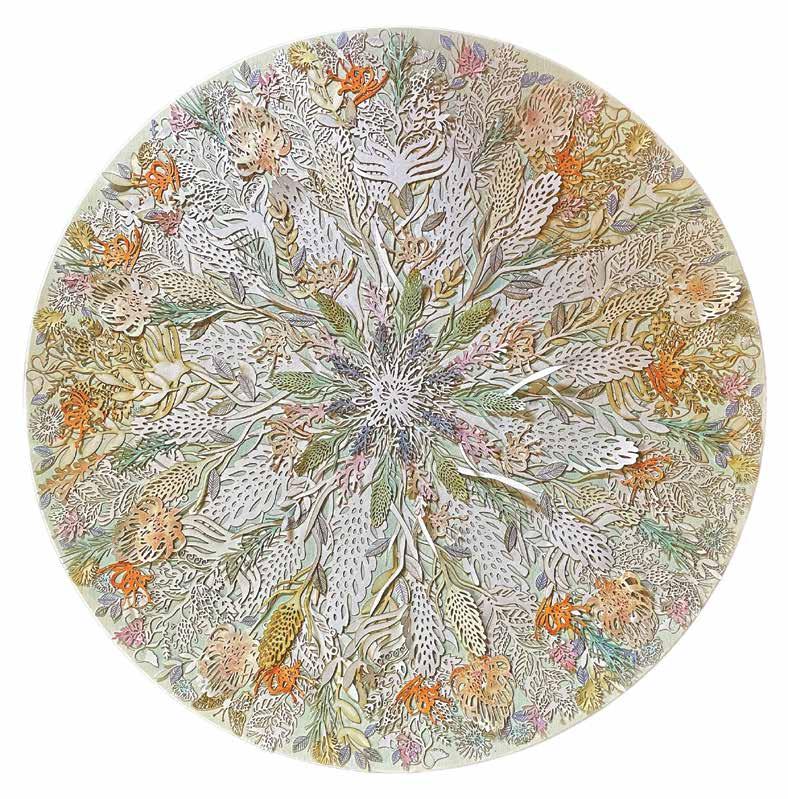
For the last ten years Sue Codee has worked predominantly with paper, creating delicate papercuts that reflect her rapport with nature and the peace she enjoys when walking through bushland or along the rugged coast near her home in Albany. She starts with drawings of plants, converts them into computer-generated ‘vector’ images, then laser cuts and assembles the sharp-edged shapes into symmetrical mandalas. Tinted with soft washes of ink that mimic the muted tones of the bush palette, multiple layers of papercuts reveal the underlying patterns and interconnectedness of nature.
These daily walks have taught me about the seasons of life. They instil a calm and simplicity that leads to acceptance and understanding of life’s ever-changing nature. This is not a loud work but rather an offering to the stillness within us all. SC
Since completing a Bachelor of Arts at Curtin University (1988), Sue Codee’s creative practice has ranged from public art commissions, community arts and consultancy to multiple exhibitions in WA, interstate and overseas. Her work is represented in many collections and her practice has expanded into a successful business. She has exhibited in the Survey on two previous occasions (1995, 2016).
As a multi-form artist, Rebecca Corps’ practice is confined only by her curiosity. Her passion for sacred art began when selected as a finalist in the Mandorla Art Award (2021). This led to her recent enrolment in theological studies and a Masters of Sacred Art which she will complete in Florence in 2022.
Inspired by the Byzantine icon Living Waters, The Divine Within depicts the holy Mother and
Child and the life-giving water that flows from this union. Capturing in essence, both human and divine, Corps explores the possibility of the divine in us all, as well as in the natural world. Her choice of support plays an important role in her practice, and she is drawn to materials that add to the story of each creation. With this particular work she has used the grain of the wood to guide her mark-making.
A former dress-maker, Rebecca Corps graduated with a Bachelor of Visual Art Honours from ECU, Bunbury (2016). Since focusing on her art practice, she has exhibited widely in WA, undertaken a residency in Finland, curated exhibitions and currently manages Stirling Street Art Centre in Bunbury. Her work is represented in the City of Bunbury collection. This is her second appearance in South West Art Now (2016).
The Divine Within (detail) 2022 tempura and gold leaf on marri

Challenging the contradiction of ‘lovely-to-lookat’ exotic plants with their pervasive presence in natural ecosystems and waterways, Molly Coy’s Pretty Plagues adopts the form of an elongated artist book to explore the metamorphosis of landscape from forest to farmland and the unavoidable invasion of a feral flora monoculture – the arum lily. As it folds and unfolds, the book’s multifaceted structure allows visual readings to shift continually and reveal simultaneous narratives. Integrating form and content, Coy creates an intersection between painting and sculpture.
The creation of ‘Pretty Plagues’ grew from both my love and concern for South West landscapes and delight in visual storytelling within the structure of an artist book. MC
From restoration bookbinder, painter and printmaker to limited edition and one-off artist’s books, Molly Coy claims she took a leap of faith which resulted in a major art prize and works being acquired by the National Library of Australia, State libraries in WA and Queensland, Iowa State University, plus numerous private collectors. This is her second appearance in South West Art Now (2018).
Pretty Plagues (detail) 2022
artist book: acrylic paint, ink, mono-printed archival tissues, frottage, coloured and gold foils circa 62 × 450 × 50
image: Alan Coy
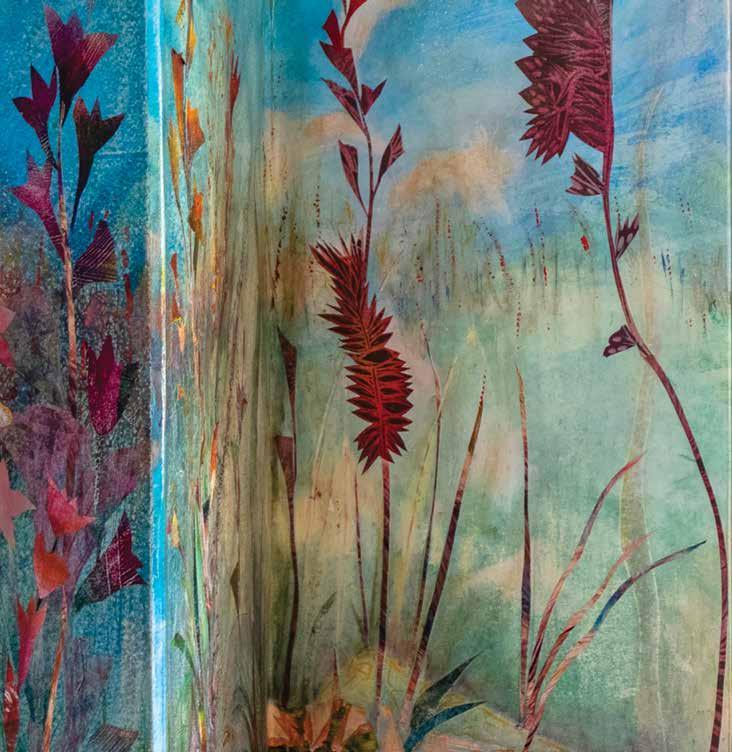
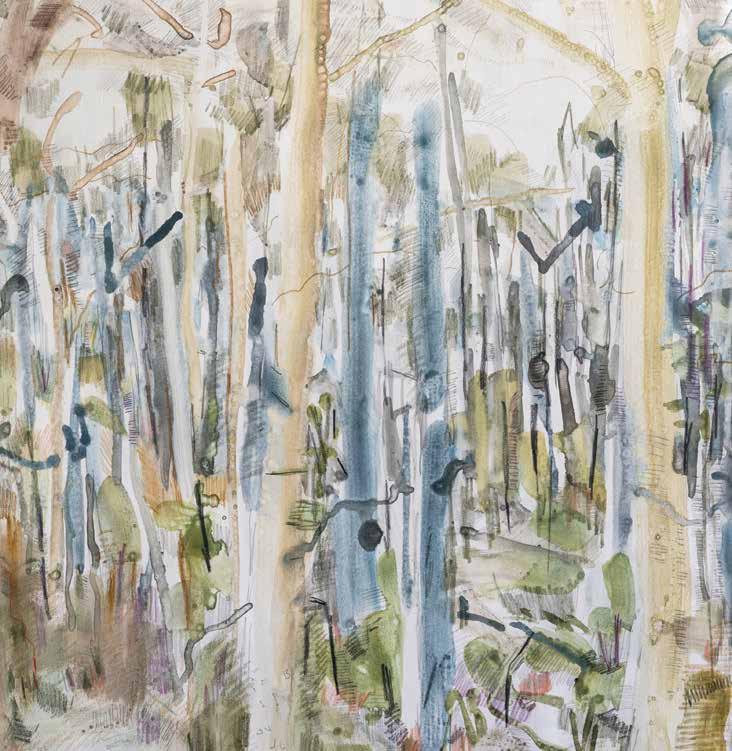
Boranup Forest (detail) 2022
watercolour
monoprint on Arches BFK with pastel and pencil triptych, each panel 96 × 73
image: Miles Noel
Enchanted by its breath-taking beauty, Jo Darvall walks in Boranup Forest and makes plans to return. Over the next two weeks, she revisits a particular pocket of bush to record the movement of light through tall Karri trees, wildflowers, orchids and fungi – eager to capture the ‘theatre’ of this majestic forest in a collection of drawings, paintings and sketches. Four months later, this same grove will be transformed by a raging bushfire.
This event made me realise the significance of capturing a moment in time. In Wardandi Noongar, Boranup means place of male dingo. The dingoes are long gone, but the Karri trees remain, for the time being. The forest will regenerate in years to come. Scarred and blackened tree trunks, though shocking to see in stark contrast to its former splendour, are also part of this rejuvenation. JD
Jo Darvall completed studies at the Victorian College of the Arts (1990), Melbourne before relocating to Perth with her family. An accomplished artist who specialises in oil painting, watercolour and printmaking, Darvall has exhibited widely in Australia, China and Singapore, and been shortlisted for many awards. In 2018 she co-founded the Swan River Print Studio at Goolagatup Heathcote Gallery. Her work is represented in public, private and international collections.
Annette Davis is fascinated by the layers of history of a particular place and inspired by the idea of nature being a witness to history. Her art is informed by direct experience of the landscape, with bushwalking and camping giving the opportunity for immersion over time in particular environments. Through close observation, sketching, drawing, photography, frottage and working with materials found in nature, she explores her understanding of the natural and human history of that place. A Walk on the Hill takes us for a walk over the granite rocks and through the varied textures and colours of the bush in Albany where she lives.
I enjoy the meditative process of stitching. It’s like walking – a repetitive action, one step or stitch at a time. The cloth has been dyed in eucalypt bark and leaves. It carries the memory of the tree, while the recycled grey woollen blanket holds its own memories. Wrapping the weathered sticks in embroidered cloth holds in the memory of the sticks. The nerves in our brain and body, including the neural pathways that relate to memory, are wrapped in a sheath, like the stick is wrapped in fabric. AD
A Masters of Philosophy in Australian Studies (1991) and a BA Honours in History (1983), both from UWA, coupled with lived experience in regional and remote communities, underpin Annette Davis’ creative practice as an artist and curator. She has exhibited widely in group and solo shows and her work is represented in private and public collections. This is her second appearance in South West Art Now (2018).
70 × 160
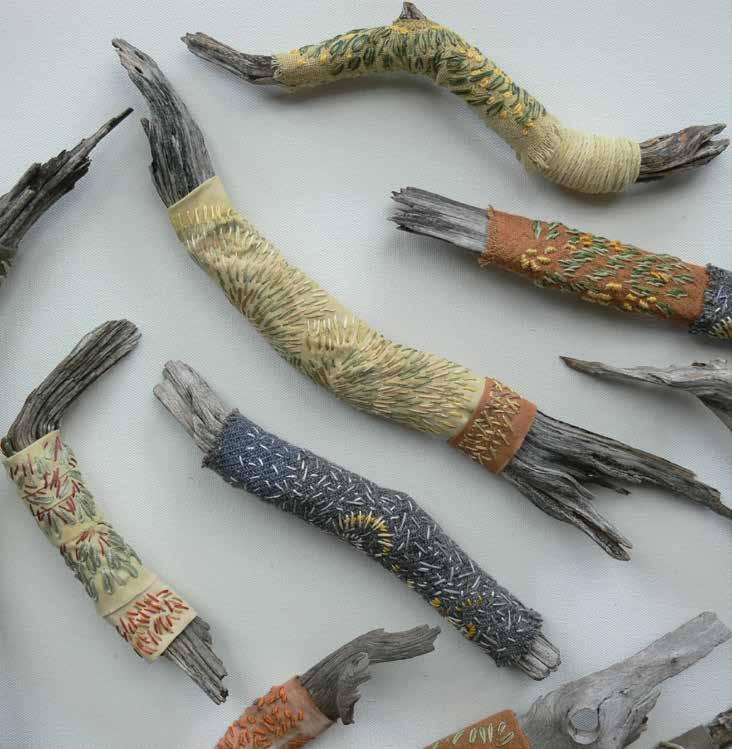
Merle Topsi Davis is a multimedia artist who adopts a hand-made aesthetic to express her concerns about consumerism, waste and pollution. Weaving, stitching and coiling, she constructs objects made from recycled and discarded materials to convey a clear message about the effect human activity has on the environment. Fabricated from beach finds, both man-made and natural, Beached, Bleached and Leached is a colossal statement about pollution and waste in the form of gigantic flowers inspired by sea anemones.
I created these flowers from beach-combing finds assembled together with weathered discarded fishing debris. I want to draw attention to issues such as plastics in the ocean, over harvesting natural resources, global warming, and the fragility of life and the environment in the 21st century. MTD
Since graduating from the West Australian Institute of Technology (Curtin University) in 1968, Merle Topsi Davis has specialised in textiles and printmaking. Throughout her career as an artist, teacher and community arts facilitator, she has exhibited regularly in WA and interstate. Her recent work featured at Sculpture by the Sea at Bondi and Cottesloe (2019, 2021) and the Indian Ocean Craft Triennial (2021). She first exhibited in the Survey in 1992.
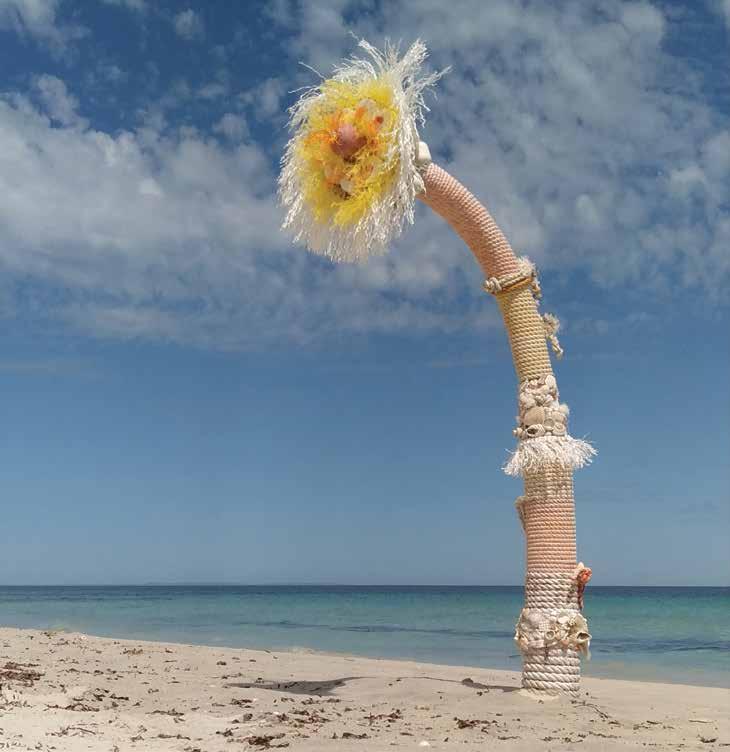
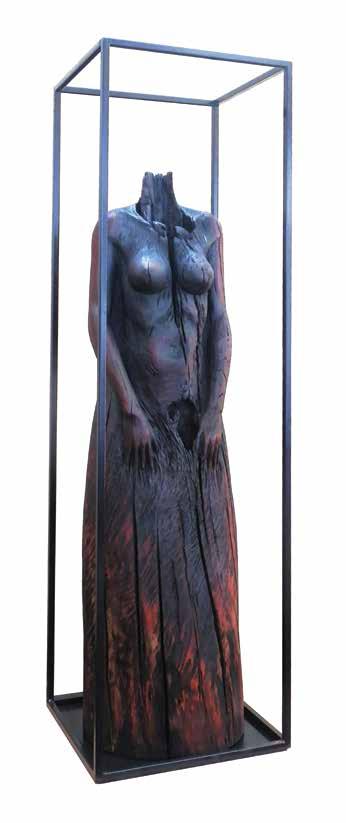 Mantle (Encapsulated) 2021–22 jarrah and steel 204 × 58 × 56
Mantle (Encapsulated) 2021–22 jarrah and steel 204 × 58 × 56
The magnetic language of wood is paramount to Tony Davis’ sculpture practice, and a deep-rooted respect for the environment has led him to develop a more sustainable approach to his process. Coupled with a fascination with ancient cultures, whose art reflects intimate relationships with the environment, he expresses these associations in the context of a volatile and rapidly-changing contemporary world.
Often created in concert with corten steel, Davis’ enigmatic wooden forms represent (western) stereotypes. He thinks of them as receptacles for encounter and contemplation. Through an intentional and incongruous association of symbols, his aim is to spark the imagination whilst retaining creative autonomy free from expectations of a prescriptive response.
I want to encourage conversations and awareness about the future. TD
Following a career in art education concurrent with his practice as an artist and fine wood craftsman, Tony Davis’ interest in sculpture evolved from a desire to extend his repertoire beyond two-dimensional imagery. He has exhibited regularly in WA and interstate, including Sculpture by the Sea at Bondi and Cottesloe, leading to several commissions. He first exhibited in the Survey in 1991. His work is represented in many collections including the City of Bunbury.
Separateness encapsulates an intense period of Joshua de Gruchy’s life. Through a strenuous process, he says he came to understand himself and his circumstances. From a place of fear and compulsion he reached a mindset of trust and liberation. For de Gruchy, the work symbolises the ebb and flow of life, the conclusion of the past and emergence of a future; a reminder to hold faith in the process and respect the necessity of these moments.
This painting evolved as my perceptions shifted. At first a confronting and overwhelming visual image, like holding strong eye contact with an unfamiliar person, slowly its appeal increases as the white surface retreats behind its layers. For me, this dark work has become very bright indeed. JdeG
Joshua de Gruchy is an emerging artist from Dalyellup near Bunbury, whose creative style has evolved independently. He often works on a large scale with acrylics, aerosol paint and inks, and has begun experimenting with oils. He expresses his internal mindset through vibrant repetitive patterns that offer a form of meditative release. This is his second appearance in South West Art Now after 2020.
Separateness (detail) 2021 synthetic polymer and pumice grains on polycotton canvas 200 × 200
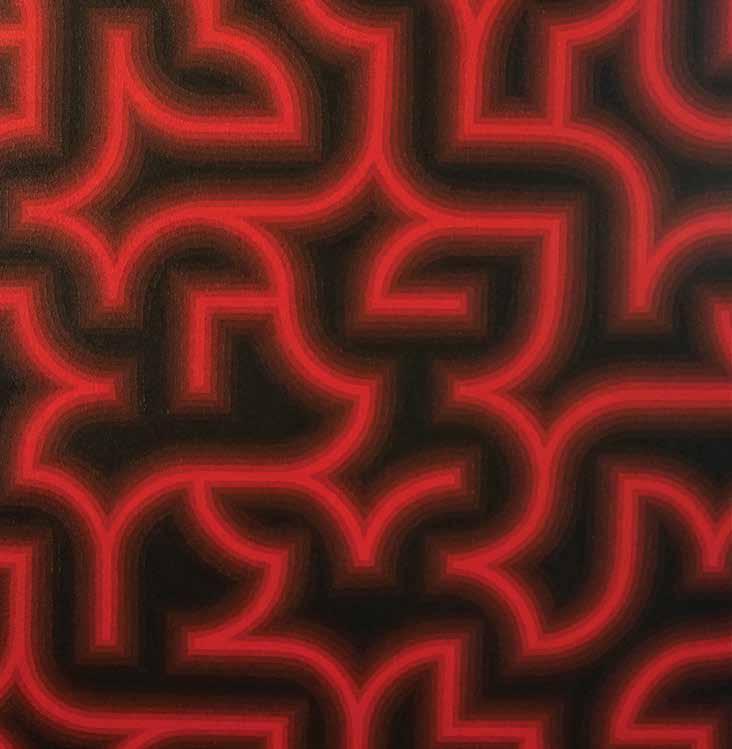

Saed : Seed 2022
artist book: handmade paper, watercolour and ink drawings, monoprints, frottage
circa 5 × 35 × 35
Saed : Seed continues Sue Dennis’ exploration of the many forms the artist book may take. Inspired by the shape and design of seed pods, she combines seeds of ideas and botanical organisms in various book-like forms to mimic the discerned and mystical knowledge contained within natural and human cultures.
The arrangement of seeds in a pod reminds me of neatly stacked pages or library books. Each seed, or page, contains within its structure all the information needed to create a new plant: in other words, a dynamic package of ideas, potential and knowledge. SD
Sue Dennis (born Bromley, UK) studied at South West Regional College of TAFE before receiving her Bachelor of Arts (Visual Art) at Edith Cowan University in 2005. She is a member of The South West Printmakers and exhibits regularly in group shows. She has exhibited in the Survey/South West Art Now many tmes since 2004 and won a City of Bunbury Acquisitive Award in 2009.
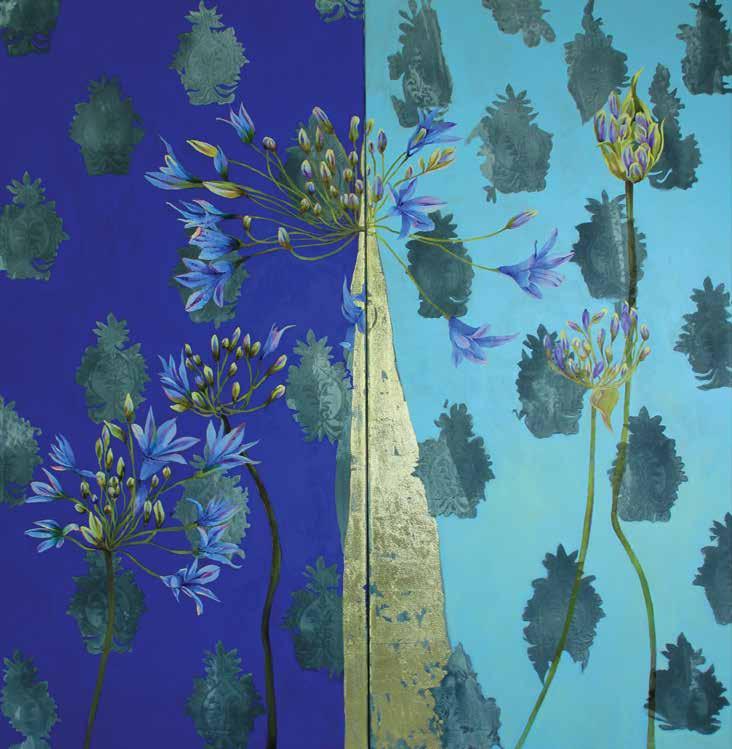
Glimmer of Hope
2022
oil on canvas
diptych, 122 × 122
Jenni Doherty’s vibrant paintings ooze colour and optimism. Recognising she lives in a ‘charmed’ environment, she aspires to obscure the worries of everyday life by creating works that are joyful and bright. Her visual vocabulary comprises recurring motifs and patterns. Are they simply decorative features or an oblique allusion to the rituals and repetitive behaviours that occur in our daily lives? Perhaps their purpose is not so contrived.
I created this painting in a time of great upheaval and uncertainty, where the future of the planet is precarious and our daily lives messed about by uncertainty. It symbolises a place to go for rest and hope. JD
Jenni Doherty has had a long and prolific career as an artist. With a qualification in art education, she has taught painting, textiles and drawing in schools, at tertiary level and privately. She exhibits regularly and her work is represented in many collections, including the City of Bunbury. Existing catalogues show her history with the Survey dates back to 1988.
Observation of rhythmic patterns and their progressive development characterise Ian Dowling’s ceramic works. This applies whether he is making a small porcelain teacup, large sculptural form or an arrangement of multiple modular segments for a public art commission. This approach has led his work to evolve into visually-complex symbolic forms overlaid with interacting patterns.
They have aspects of decoration and function common in the potters’ world but my attention is focused on the enclosure contained by the boat-like form that serves as a beautiful protective space. ID
Dowling draws on a range of techniques to achieve these effects, the physical process of making as important as the final result. He begins on the potter’s wheel, adds and subtracts elements, and reshapes the object by hand or with slabwork and cast sections. Gradually he is developing a more sustainable way of working, using local materials for making and glazing, and firing to high temperature with wood sourced from coppiced trees onsite.
Inspired and encouraged by many leading figures in the ceramics world, Ian Dowling’s career as a potter and ceramic artist spans fifty years, forty in Margaret River. He completed a Master of Visual Arts through Monash University (2003) and further studies in contemporary craft (sculpture) at Central TAFE (2008). His large-scale architectural commissions have featured in publications in Australia, the UK, China and the USA. His history with the Survey dates back to 1989. He won the City of Bunbury Acquisitive Award in 2007 and an award for excellence in 2009.
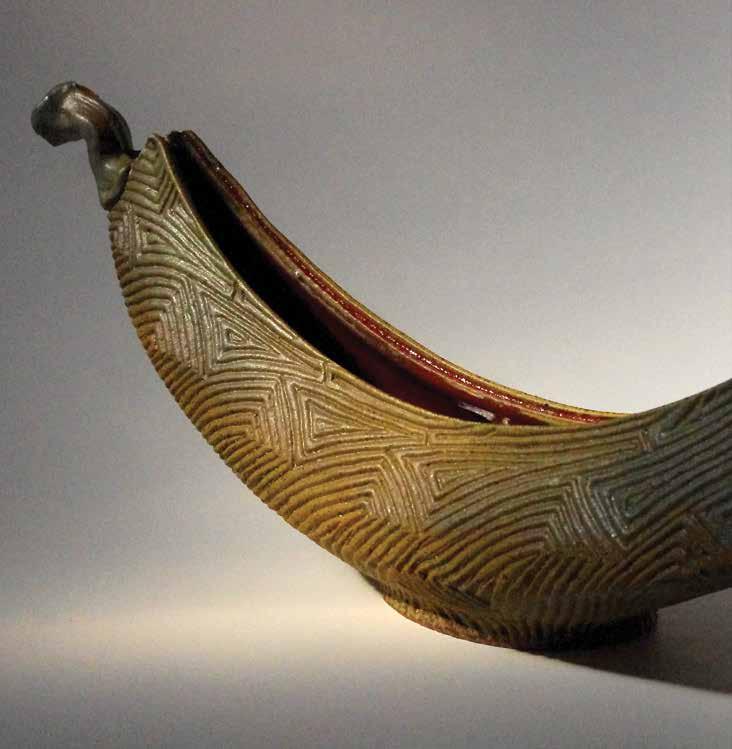
Elizabeth Edmond’s artwork combines her palaeoecological knowledge of peatlands with a desire to raise awareness about these habitats. Her detailed fine ink drawings on rice paper are an intimate exploration of the identity of trees, each with their own distinctive qualities; collectively they represent diversity. By printing these drawings on chiffon banners she extends the work further, creating a flow-on effect of gentle movement and transparency that imitates the layered complexity of fragile peat systems.
Peatlands may not appear much at first glance, but look closer and you’ll be amazed at how unique they are. Covering just 3% of the world’s surface they hold nearly one-third of the planet’s soil carbon and here in the southwest we know very little about them. Some peats are 6000+ years old and they are found throughout lowland areas as fragile habitats threatened by drying climates, altered fire regimes, clearing and feral animals. ‘Moving through Peaty Lowlands’ allows you to brush against 1000-year-old paperbarks, 600-year-old grass trees, aged banksias and relictual sedge-like plants such as Empodisma gracillimum and Reedia spathacea. These species are important ecologically in peatland habitats. If a layer is removed or a species lost, the habitat is altered forever. EE
Dr Elizabeth Edmonds is a renowned research scientist as well as a visual artist. She lives and works in Walpole in the south west of WA – an international biodiversity hotspot where she owns and operates Petrichor Gallery. She exhibits regularly and her work is represented in many collections in Australia and overseas. This is her third appearance in South West Art Now since 2018 and 2020.

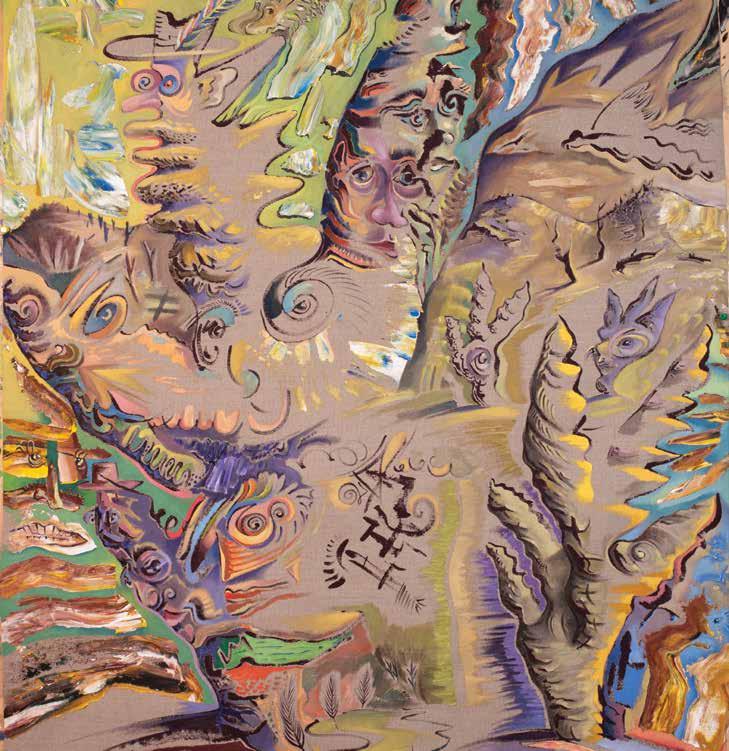
Coastal Landscape
(detail) 2021
acrylic on Belgian linen
Robert Ewing’s long-term interest in the elusive characteristics of landscape has generated a familiar visual vocabulary of emblematic motifs. Through these mysterious elements that appear recognisable yet never fully understood, he endeavours to evoke the interplay between sense of place and a changing natural environment. Recently he’s been drawn to the mysteries of the cosmos and its relationship with planet earth.
Throughout the ages various investigators of the mysteries have studied, noted and talked of a great year/cycle. Our earthly place and our intrinsic connection with the cosmos; an ever-changing dynamic of repetition and cycles around the sun intersected with traversing comets and other celestial objects. Since ancient times stories have been told of fire raining from the skies, great floods and mountains of water. These stories are shrouded in mythology and remain present as mysterious manifestations of religious emphasis. RE
Robert Ewing is a Pinjarra-based artist whose work embraces metaphysical questions and poetic insights. A graduate of Claremont School of Art (1985), he has worked extensively in community arts projects. He has exhibited regularly in WA and interstate. He first took part in the Survey in 1992 and won the BHP Billiton Award for Excellence twice (2013, 2014). His work is represented in many collections including the City of Bunbury.
Galliano Fardin’s response to the complexities of the contemporary world is to care for a particular patch of land and create habitat for wildlife. He sees no separation between these activities and his paintings, where geometric shapes, rhythmic patterns and layers of colour convey his perception of the forces of nature and existence.
Pursuits of power and wealth appear to jeopardize the checks and balances of our planet … Unfortunately if we carry on with our indulgences, we may find that we are getting nowhere. Lake Clifton is a place where it is possible to appreciate time and space detached from the hustle and bustle of ‘now’. It is home to one of the most ancient forms of life on earth, thrombolites, which is food for thought. Lake Clifton is also near enough to the Indian Ocean to hear the roar of the surf crashing on the coast some mornings. ‘Surge’ is a meditation on the energy of water pounding the ocean shores in a never ending cycle. GF
Galliano Fardin moved to Australia from Italy in 1972. He has a BA in Fine Art from Curtin (1986) and studied at the Museum of Fine Arts in Boston. He has an extensive record of exhibitions and his work is represented in many collections, including the National Gallery of Australia and Art Gallery of WA. He took part in the Survey in 1989 and 1994, when he won the overall award.

Through an exploration of form that responds to the dynamic natural beauty surrounding his Gelorup studio, Frazer welcomes the viewer into dialogue that shares the embrace and dislocation of how we experience a sense of home.
I grew up here but I’m not sure I recognise it anymore. I’ve walked the streets outside a thousand times, but now I can’t go inside. I have always cared for this house and for those that call it home, but something has changed. The light is still on and the door remains ajar though not everyone can enter. It’s not the direction I imagined the path to turn and I still have hope it will not remain this way forever. I won’t spend my days waiting outside because life is far too short. Come, let us break bread and share wine under the trees where there is no door. AF
Andrew Frazer is a multi-disciplinary artist from Gelorup near Bunbury. In addition to his own practice, he is the Founder and Creative Director of Six Two Three Zero – a Bunbury-based initiative that uses public art as a catalyst for urban development and social change. They are responsible for commissioning large-scale murals in Bunbury, Armadale and Collie. He exhibited in the Survey/ South West Art Now five times between 2005 and 2020.

Memorial evolved out of Richard Fry’s fascination with diatoms – microscopic creatures that live in water – and their role in ecosystems. His curiosity soon became intertwined with unravelling his grandmother’s story.
Mary Ann Thompson sailed for Australia from England with her young daughter (Fry’s mother) in 1915. She settled in North Perth to raise her daughter alone until she met Arthur Thomas in 1921. To hide the illegitimacy of her child, Mary had led everyone to believe she was a war widow. She died on 6th September 1939, three days after the declaration of World War II. Starting with little more than a death certificate and one photograph, years
of research led Fry to discover who his grandfather really was – Stanley Strange, a wholesale draper’s traveller who died in late August 1939, shortly before the start of WWII. Coincidentally, both his mother and grandmother worked as haberdashers before they married.
I grew up without knowing my grandmother. Like the diatoms, I wonder how someone so beautiful could exist without me knowing anything about them? ‘Memorial’ is an acknowledgement of her existence, a monument to heal the hidden shame that has plagued my family’s memory. RF
Richard Fry lives in relative seclusion in Noggerup. He has a Diploma in Fine Art from Claremont School of Art (1981) and a BA in Fine Arts from Curtin (1994). He works in glass, ceramics and steel, exhibits regularly and his work is represented in many collections including the Art Gallery of WA. He has taken part in South West Art Now twice before (2016, 2018).


Timeless Treasure
(detail) 2022
Kay Gibson’s practice combines a love of printmaking, drawing and painting with a passion for working on and with paper. The Margaret River region has been her home for almost fifty years and her work often portrays the flora and fauna of the area. In Timeless Treasure, she has used some of the plants that grow along the Margaret River to create soft ground etchings printed on rice paper which has been hand-coloured and torn to create the image.
When viewing the landscape, I often wonder what it would have been like for the first people that lived here, the Wadandi People. Having intimate knowledge of the land was crucial to their everyday life and survival, which sustained them for thousands of years. Today our lives are not as obviously or as directly-dependent on the plants and animals around us, but we must know their role in order to maintain healthy ecosystems. ‘Timeless Treasure’ is a homage to this beautiful and vital river. KG
Since graduating with a BA (Visual Arts) Hons. from ECU (2005), Kay Gibson has lectured at South West Regional TAFE, exhibited widely, been shortlisted and won several awards in WA and the eastern states, including the Waterhouse Natural History Prize (2010, 2012). She has exhibited in the Survey many times and won a City of Bunbury Acquisitive Award in 2009. Her work is represented in many public and private collections.
Ruth Halbert is a life-long textile artist. She was raised in the wheatbelt where hand-making with natural materials was part of her childhood. With a background in science, she often uses number-play and patterns in her work. Intrigued by the conundrum of its form, she began making work based on the Möbius strip in 2010. A Möbius is made by taking a rectangle, putting a half twist in it and joining the two short ends. It is three-dimensional but has only one surface and edge. She explores this form using various textile materials and methods; playing with scale, transparency, multiples and symbols to contain the challenge of opposing tensions.
Turn is a Möbius made from a simple rectangular piece of handwoven cloth, identical on both sides. Removing and adding warp and weft threads throughout the weaving process changed the density and transparency of the cloth in a gradient which can be followed around the infinite loop. A slight but strong linen yarn supports the form as it hangs in space.
A Möbius has no right or wrong side, no top or bottom and no beginning or end. In these fragmented, polarised times the Möbius seems to promise an enigmatic wholeness. RH
Since graduating with a Bachelor of Arts (Visual Arts) from ECU in 2012, Ruth Halbert’s practice has evolved from making for pleasure to using textiles to investigate social, historical and environmental issues. She exhibits regularly and her work is represented in many collections in WA, the UK, USA and Sweden. Halbert lives in Denmark WA on unceded Menang Noongar boodja.
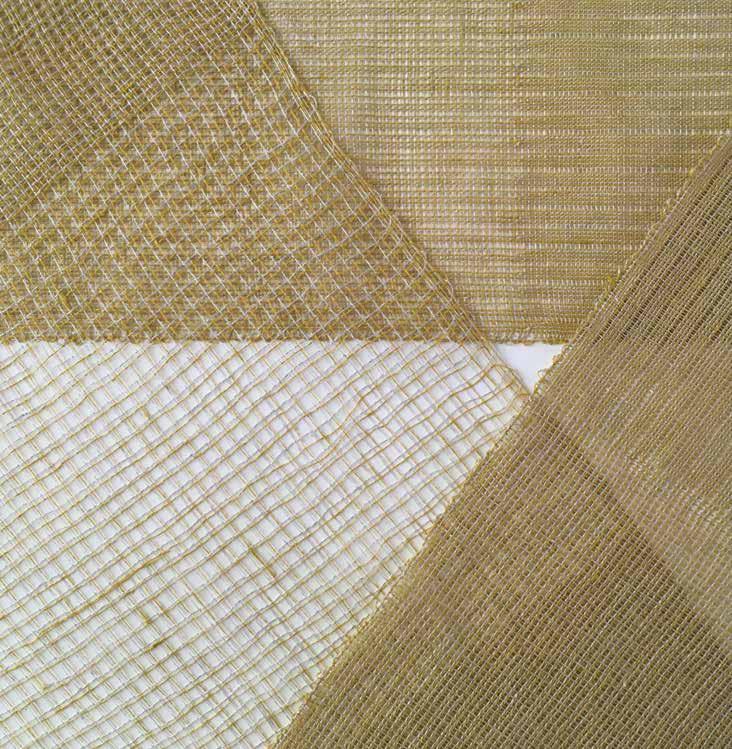

Catherine Higham is an artist and farmer who makes work that questions what it is to be human within living systems that converge. In 2018 the presence of bee hives near her farm and contact with a professional bee keeper inspired her to investigate beeswax. In Radii she uses an encaustic painting process – layers of hot beeswax infused with pigment – and gauged marks to suggest temporal patterns of arrival and departure based on a gold mine near Boddington WA. Higham refers to the mine site as a biosphere where humans and other living species such as bees co-exist. By juxtaposing two disparate species, the bee and the miner, her intent is to compare the similarities of their roles, coming and going from the location.
Although many living species have been found at and near mine sites, I have chosen to study two; the bee and the miner. Both species have roles to play in structures that will outlive them; the hive and the mine. CH
A graduate in visual arts and education, Catherine Higham uses research-based practice and diverse materials to investigate environmental themes. Originally from Tasmania, she now lives in WA’s Great Southern. She exhibits regularly and her work is represented in various collections, including the City of Bunbury. She exhibited in the Survey/South West Art Now in 2013, 2018 and 2020.
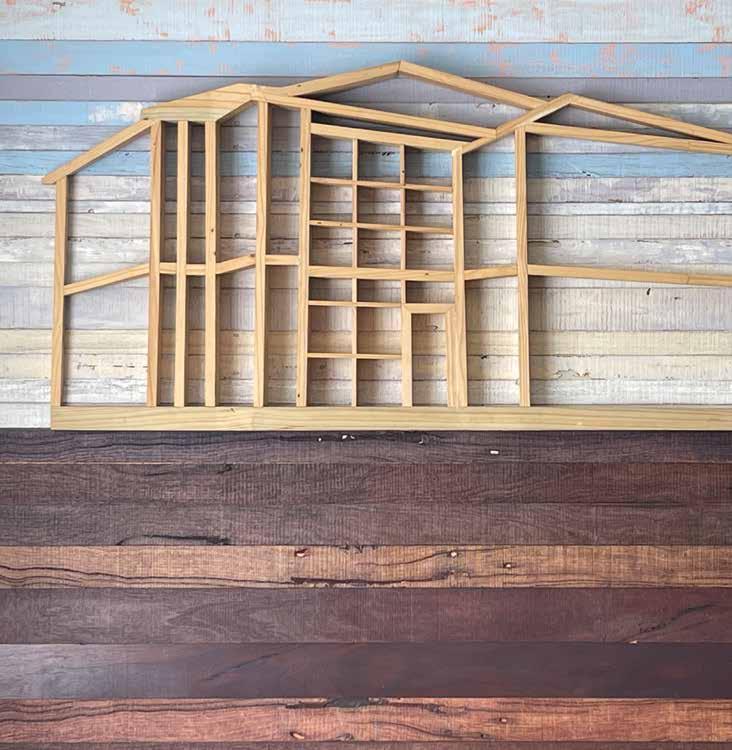
Concept house and the bands of time
(detail) 2022
acrylic and oil on timber (pine, marri and jarrah)
166 × 204 × 20
Peter Hill works in both 2D and 3D formats for interior and exterior locations. Melding visual skills from painting with a sculptural sensibility, he works (or plays) with the juxtaposition of illusion and the tactile physicality of timber.
As this artwork has evolved it has become a dialogue between an architectural plan for a future home (Concept House) and the imagined landscape within which it could rest. Superimposed over layers of time, the house holds and is held by echoes of the past, hints of an everchanging present, and windows of possibility that look into the future. PH
Born in Manjimup, based in Northcliffe, Peter Hill has retained close ties with the southern forest throughout his life. He completed a Diploma in Art and Design (Claremont School of Art 1993) and built his practice through numerous exhibitions, public art commissions and representation in many collections including the Art Gallery of WA. He took part in the Survey/South West Art Now in 2010 and 2020, when he won the Geographe Winemakers Award.
Val Hornibrook lives on a wool-producing property on the Capel River close to the ocean. They are both sources of inspiration for her textile practice. When the winter rains arrive, water flows downhill towards the river, forming mesmerizing channels across the paddocks. Starting as a trickle as it seeks the river below, the water picks up momentum until it reaches its goal, to then be carried out to sea.
Felting is an ancient technique where natural fibres are manipulated into layers of fabric. From an initial idea based on topography mapping, Hornibrook has used home-grown naturally-coloured and hand-dyed merino wool to represent the watercourses and riparian vegetation. Additional threads depict splashes of water.
My interest turned to felting 21 years ago. I love the feel and touch of the wool. There’s always an element of surprise when the work is finished. VH
Val Hornibrook has been working with textiles and felting techniques for many years, using a variety of materials including merino wool fibres, wool/silk yarns and hand-dyed fabrics to create 2D and 3D designs. She is a member of Feltwest WA, teaches, and exhibits regularly, including Wearable Art Mandurah and the World of Wearable Art, New Zealand. She has exhibited in the Survey on one previous occasion (2013).

In the six years since Deborah James took up pottery she has explored numerous techniques in both handbuilding and thrown work, functional and non-functional. Intrigued by the unpredictable outcomes, she enjoys experimenting with alternative firing techniques, particularly raku in its many forms, as well as using soluable (or metal) salts as the sole decoration on porcelain. Her current work includes domestic ware and idiosyncratic animalia. Quattuor Equos Apocalypseos Australia represent bushfire, storm, drought and species extinction. A twist on the four horsemen of the apocalypse, the intent of the four stylised horses is to generate discussion about environmental issues and the effect of climate change on the Australian landscape.
Climate change is now affecting all of us in Australia, as well as the myriad other species that share this land with us. Clearly our past and current activities are unsustainable and change is urgently needed. DJ
New Zealand-born Deborah James moved to the outskirts of Bunbury in 2013 following ten years in Mildura, Victoria where she practised as a nurse and co-owned a craft gallery. She now exhibits locally with other makers. She studied Art History, English and Philosophy as part of a BA at Flinders University (1989), taught ceramics with Bunbury Studio Potters and currently teaches with Bunbury Regional Art Gallery’s Noongar Arts Program.
Quattuor Equos
Apocalypseos
Australia: Bushfire, Storm, Drought, Extinction (detail)
2022
raku fired stoneware
26 × 26 × 10 each
image: Julian Bowron


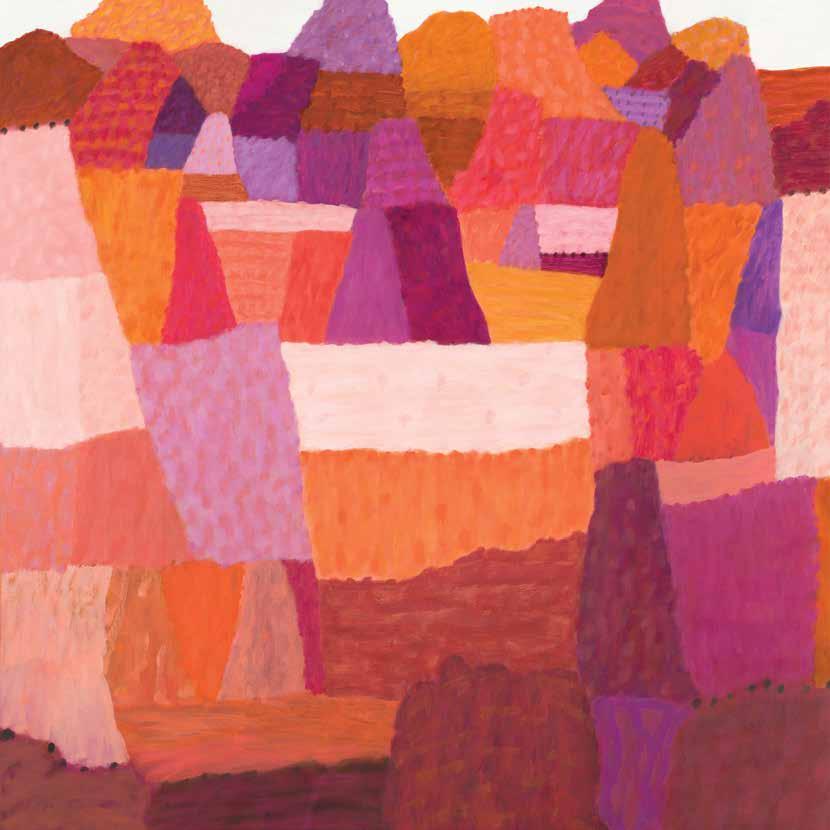 Mary-Lynne Stratton
Jewelled Ranges Northern Territory (detail) 2022 oil on canvas diptych, 100 × 200
image: Nathan Wills
Mary-Lynne Stratton
Jewelled Ranges Northern Territory (detail) 2022 oil on canvas diptych, 100 × 200
image: Nathan Wills

Victoria Baker and Davina Jogi are visual storytellers with a shared interest in documenting their community. This drove them to create a collaborative film The Defenders, a multimedia project that situates portraits of local bushfire brigade volunteers alongside their environment in the Shire of Bridgetown-Greenbushes.
Jogi says she’s a political creature, a Zimbabwean migrant of mixed cultural heritage, a writer and researcher, all of which inform her photojournalistic practice. She is interested in visual storytelling that questions and advocates. Her sense of fairness and desire to be where the story is enables a socially-engaged perspective of the bushfire service as it faces the challenge of lengthening fire seasons and an aging volunteer base.
Baker values the medium of photography as an art form and way of recording history. She sees her portrait photography as a record for the future and strives to catch a sense of her subject’s character; in this instance the image of a stoic local community at the frontline of climate change.
The combination of Victoria’s portraiture and my photojournalistic imagery highlights the unseen, ordinary people whose livelihoods, families and histories are as invested in the Australian bush as they are devastated by it. DJ
Davina Jogi has been a documentary photographer since 2008. She is CoFounder and Director of Zimbabwe Association of Female Photographers, has exhibited in South Africa and Australia, and was a jury member for the World Press Photo Foundation (2019, 2021). Currently she is undertaking a PhD at Curtin University. Her work is represented in collections in France, Sweden and at the National Gallery of Zimbabwe.
Since graduating with a BA (Hons) in Photographic Communication from Falmouth College of Arts, Cornwall (2001), Victoria Baker has worked as a freelance photographer, first in London then Bridgetown where she moved in 2011. Jogi and Baker were finalists in the National Photographic Portrait Prize at the National Portrait Gallery, Canberra (2021).
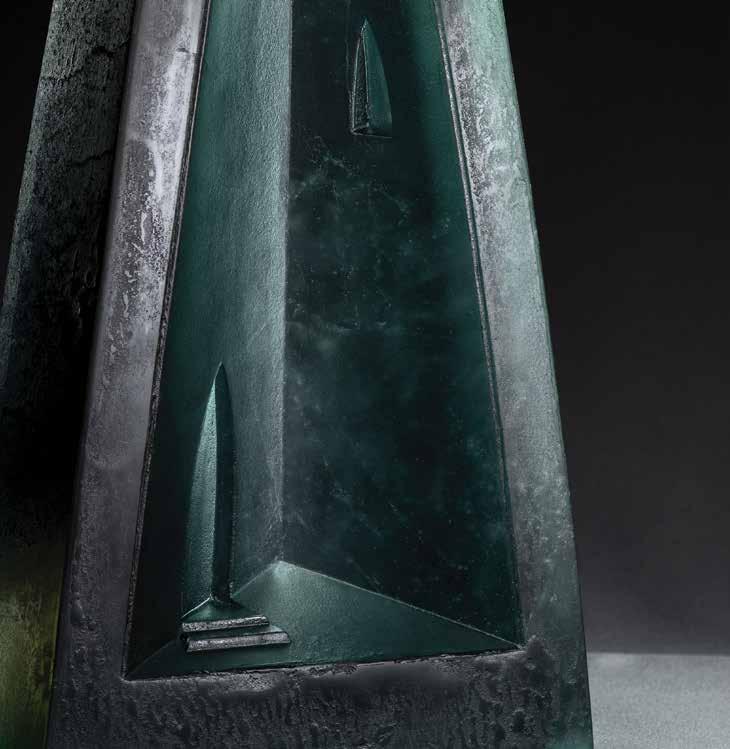
Peter Kovacsy has always been fascinated by the challenge of working with wood or glass, or combinations of both, creating sculptural objects for exhibition or on commission. He established his practice as a designer-maker in Pemberton in 1989, specialising in fine wood furniture and bespoke objects. He switched his focus from wood to the design and production of large-scale kiln-cast glass sculptures in 2022.
A background in the alternative building industry has led him to claim the art of designing and building structures, especially habitable ones, is in his DNA; so translating architectural form into cast glass sculpture is an inherent characteristic of his creative practice.
Sanctuary: close your eyes – imagine you are standing before a place where someone or something is protected or given shelter –a light is glowing within. PK
Peter Kovacsy is self-taught and dedicated to excellence. He has exhibited numerous times in Australia and overseas, including the Art Gallery of WA’s Tom Malone Prize (2018, 2021). His work is represented in many private, public and corporate collections, nationally and internationally, including the Art Gallery of WA. Kovacsy’s history with the Survey dates back to 1991. He also took part in 1995, 2005 and 2020.

Geologic Timescale
(detail) 2022
encaustic and oil on board
diptych, 120 × 122
image: Wayne Harrington
In her formative years as an artist, Carly Le Cerf was resident in the Pilbara region, an experience that has influenced her practice ever since. She returns to the Pilbara regularly, with her most recent excursion inspiring the body of work she created for her first major exhibition at a public art gallery. Geologic Timescale arose out of that visit, when she returned to a place she has painted many times – Hammersley Gorge.
I have painted Minhthukundi (Hamersley Gorge) many times and I’m fascinated by the layers of history patinated into the rock face. By going out into the landscape, I felt that I was also going into an internal ‘landscape’ and a state of deep introspection. In that ancient landscape, where the evolution of the earth is visible, I questioned my place as a human being and an artist in a vast historical timescale: am I merely a witness, a passive observer, or an active participant? Back in the studio, I rekindled the experience of place through sensory and visual memory, relying on the process of intuitive layering and carving; a dance between control and unpredictability, revealing the sculptural quality of wax, oil and pigment. CLC
Carly Le Cerf is an English-born artist who lives in Mount Barker. She has a BA Fine Arts (1999) and a Dip. Ed. Visual Arts (2000) from Edith Cowan University. She exhibits regularly and recently held a successful solo show at New England Regional Art Museum NSW. She works en plein air and in her studio, experimenting with encaustic wax and oil painting techniques, embedding texture into layers of paint, beeswax and pigment.
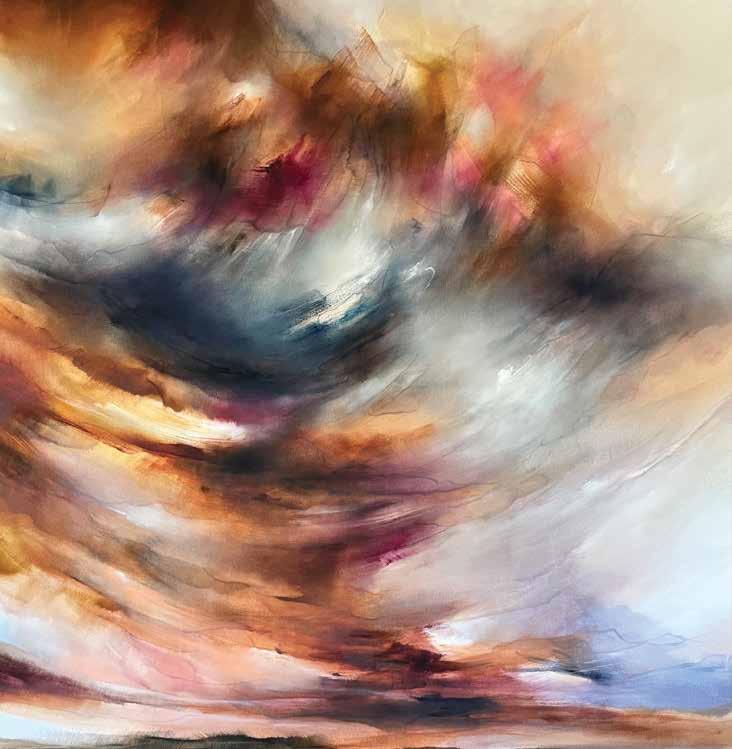
Constantly travelling until the start of a global pandemic, Alice Linford Forte translates places she has seen into whirls of colour on canvas. Her work is an expression of her mood, executed through shapes and colours. Her approach to painting is experimental, like her life; it embodies her raw emotions – exciting, unpredictable spontaneous, intuitive.
Often I reflect on certain times in my life with an urge to reproduce them in a painting, to create a lasting memory. When the Boranup fires swept through the district in November 2021, my initial emotional response was nothing but fear that we would lose our beautiful rural property. As that fear subsided, I was left with appreciation, awe, and a strong desire to capture it on canvas. ‘Silver Linings’ reflects the impending gloom and volatility of a threatening powerful force sweeping across the sky and through the landscape. Where the clouds hung heavy with blackness, the sky surrounding it maintained a heavenly, ethereal glow. ALF
Born in England, raised in Australia, Alice Linford Forte is a self-taught artist. Prior to COVID-19, her paintings featured scenes from her extensive travels overseas. With international travel on hold, she returned home to Margaret River in March 2020. Her recent work now features Western Australian imagery ranging from coastal scenes to the expansive landscapes of the Pilbara. This is her second appearance in South West Art Now
After multiple migrations Elisa Markes-Young feels uprooted, caught between worlds, always in-between, never arrived. ‘What and where is home’ she asks. ‘Here is not it.’ Yet over time she has realised home is not tied to geography or history. It exists between facts, fleeting and subjective; part place, part vague ideal seen in glimpses – unattainable, unreachable. Her work explores this profound sense of displacement.
Home, like a collage of postcards and scraps of paper, is assembled out of loss and absence, memories, desires and fear. Its power comes less from its elements than from their associations. The spaces between are made from gaps in my recollections, spaces of loss and imagination. Here, fragments of life, details and events I remember are completed by longing and desire. ‘Tęsknota’ 1 is the pain that comes from the disjuncture between now and then, here and there, presence and absence. It creates its own territory, keeping the past, the future and all the things we pine for untouched by reason and unspoiled in unreal perfection. EMY
1. Tęsknota (pln) is a sentiment that describes the loss, loneliness and incompleteness felt when recalling a joyous past or the longing for something or someone never experienced or met.
Elisa Markes-Young was born and raised in Gorlice, Poland and moved to Germany when she was sixteen. She arrived in Australia in 2002 and now lives in Margaret River. She has an extensive exhibition record, has won many awards, and her work is represented in numerous collections, including the City of Bunbury collection. She exhibited in South West Art Now in 2018 and 2020.
Spaces Between (detail) 2022 Wenzhou paper, thread, sequins dimensions variable


Land of the Rainbow Gold (detail) 2022 acrylic and thread on canvas diptych, 52 × 390
Lesley Meaney arrived in Perth in 1969 as a young artist and art teacher. Since then, her immersion in the landscape has played a pivotal role in her art practice and personal journey towards ‘becoming Australian’. Over the past fifty+ years, she has endeavoured to create whatever resonates at any point in time, using a variety of techniques and materials, shifting constantly between abstraction and representation.
My five years in the Northwest continues to ‘pack a punch’, especially in relation to the landscape’s rainbow colours and its far and wide horizons. Meandering through different landscapes produces a residue of splintered observations. Hence this four-metre painted and stitched diptych was executed in a way that is reminiscent of a barcode – an optical representation of data – a unique product identifier and typically Australian in its subject matter. I chose ‘Land of the Rainbow Gold’ as the title as a nod, not only to a line in Dorothea Mackellar’s famous poem ‘My Country’, but also to its many possible interpretations. LM
Lesley Meaney (born Bristol, UK) completed a National Diploma in Design (Twickenham 1966) and a Teaching Diploma (Liverpool 1968), worked briefly as a graphic designer and art teacher then migrated to Australia. In a career spanning five decades, she taught for many years whilst pursuing her art practice. She exhibits regularly and her work is represented in numerous collections. This is her fourth appearance in South West Art Now since 2016.

Throughout his career as an artist, mentor and academic, Paul Moncrieff has spent considerable time examining what he sees as the core of contemporary western practice – the formal principles of composition, proportion, rhythm, pattern, colour and systems. He has an ongoing fascination with the De Stijl group of artists who were active in the Netherlands in the early 20th century, and the influence of their graphics, artwork, furniture design and architecture across the world. Gerrit Rietveld’s use of mundane materials and playful yet instructive ideas for furniture and other objects is of particular interest.
Working with geometric and assembled plywood shapes allows me to explore systematic variations on a theme. In fact I would consider my work viewed as a whole, particularly in the last twelve years or so, shows a continuum of development that’s identifiable and interconnected. ‘Your Move’ is a progression from a series of works based on the semaphore, a system of signalling using bicoloured flags. I’ve evolved my own take and added a whole new layer of colour-coding based on the alphabet. This provides a whole new meaning and ‘Your Move’ becomes a visual board game to be played with and rearranged as desired. PM
Paul Moncrieff lives and works in Kent River near Denmark, WA. With a Master of Arts, Visual Arts (Curtin 1993) and teaching certificates, for many years he combined his art practice with tertiary level teaching. He has an extensive exhibition record and his work is represented in numerous collections in Australia and overseas, including the Art Gallery of WA. This is his third appearance in South West Art Now since 2016
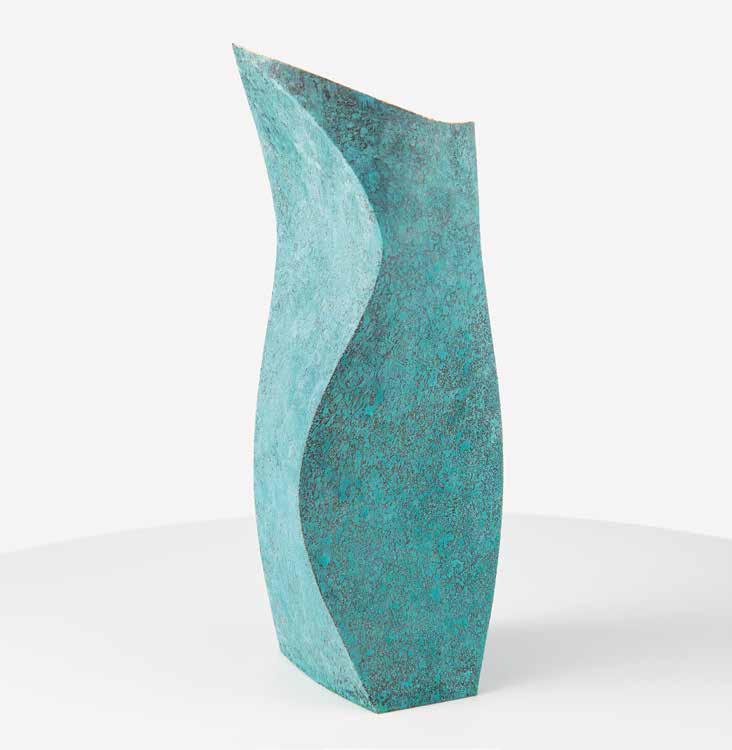
Relic I, Relic II 2022
fold formed copper vessel with heat application of patina 30 × 10 × 10, 20 × 9 × 7
image: Fran Jackson
Steve Pease’s approach to his practice draws on a wealth of knowledge and expertise spanning forty years of creative experimentation with glass and metalwork. Working at a small scale, he designs and fabricates well-conceived objects underpinned by the formalist principles of shape, structure, line and surface texture.
Relic is a series of copper vessels that explore the creation of 3D objects using the fold forming technique. The distinctive characteristic of this technique is that forms can be explored in card before translating into metal.
Copper is always such a beautiful metal to work with. The metal can be easily coloured to create a rich patina that gives the forms an aged appearance. SP
Steve Pease creates metalwork and jewellery for exhibition, commission and limited production. His commitment to arts education and experimentation with form and materials make him one of WA’s leading metalsmith practitioners. He completed a Master of Arts at Curtin (1993), is a former President of the Jewellers and Metalsmiths Group WA, and his work is represented in several collections, including the City of Bunbury. His last appearance in the Survey was in 2012.
We of the Wandoo is an embodied response to Lori Pensini’s yarnings with her friend Gloria. Gloria is a Karriyarra, Ngarluma Yindjibarndi and Yawuru woman on her father’s side and Yuet Ngaju Noongar on her mother’s. She is a healer from both lines. They first met as artists sharing knowledge about creativity. Conversations about form and markmaking soon gave way to sharing stories about their shaping as women, from the hands of past generations, seeing each other from within and beyond their skins.
Gloria speaks of a ‘oneness’; each of us individual threads of a fabric spun to form a quilt of life. The fabric I am weaving with Gloria is one of shared knowledge, healing and nurturing. I wanted to portray this kinship as gentle strength; two women supporting each other’s vitality, poised in front of wandoo blossom. The wandoo (white gum) is legendary for its hardiness and tolerance to drought and salinity. Its leaves have remedial medicinal properties. Here, it conveys the sincerity of our friendship, self-healing and shared commitment to the future health of our environment. LP
In a career spanning three decades, Lori Pensini has been shortlisted for numerous exhibitions throughout Australia, including the Lester Art Prize –formerly the Black Swan Portrait Prize (winner Toni Fini Award 2019), Doug Moran National Portrait Prize, Kilgour Prize (winner 2021). Her work is represented in a number of corporate collections.


Webb (Dwardinan)
(detail) 2021
photographed in Margaret River by Martine Perret for Mitchee Youp
Bullargar (Coming Together)
Martine Perret’s practice is based on a long career in photojournalism where she covered United Nations peacekeeping missions in conflict zones for ten years, including South Sudan, the Democratic Republic of the Congo, Burundi, Timor-Leste and West Africa. Recent projects highlight the importance of Indigenous languages and illustrate her multi-faceted approach to storytelling. The work she is showing in SWAN 2022 is a collaboration with Wardandi Elder Vivian Brockman Webb, also known as Dwardinan. The installation comprises the video Mitchee Youp Bullargar (Coming Together), a portrait of Dwardinan, and three ceremonial poles created for Perret’s recent exhibition Belong.
Like her ancestors, Dwardinan is dedicated to caring for country, particularly the coastal area where her parents documented the sites that are special to their people. As part of her Eldership, Dwardinan established sovereignty of Wardan to ensure the conservation of sacred sites and good management of the land, air and water for future generations.
‘Belong’ was presented at WA Museum Boola Bardip, Perth to celebrate UNESCO’s Decade of Indigenous Languages (2022-2032), which will focus on the empowerment of language users and their human rights. MP
French-born Martine Perret is a renowned photographic artist who now lives and works from her base in Margaret River. She is known for her portraits and photographs of the West Australian landscape which often employ aerial captures. She has exhibited her work in Australia, France, Switzerland and the USA.
Vivian Brockman Webb (Dwardinan) is a Matriarch Elder of the Margaret River region. Dwardinan is a Dordenup Wardandi language speaker. She was born in Busselton in Wardan country where she continues to live and share her deep knowledge of country. Her totems are the black cockatoo and the grey kangaroo. Her dreaming is the snake dreaming and her personal totem is the black swan.
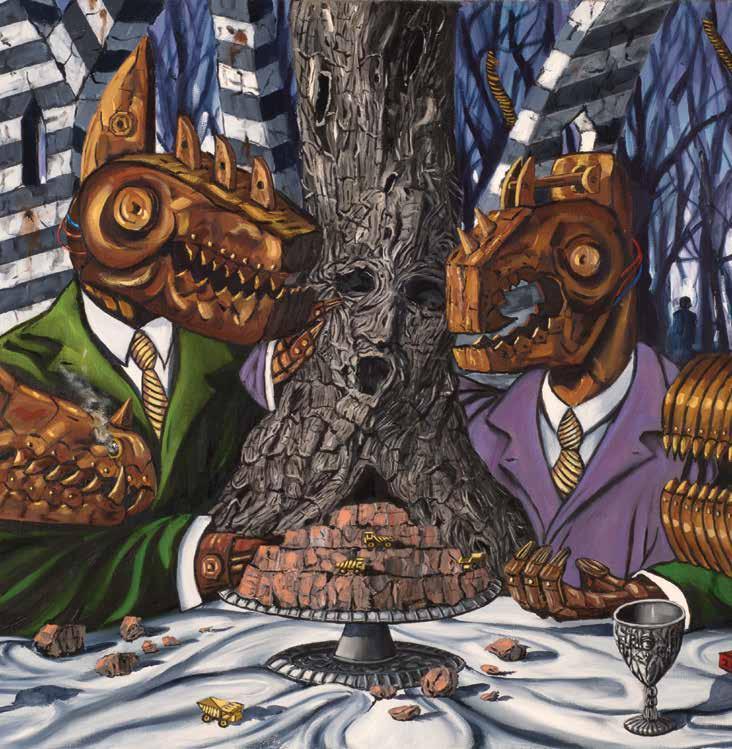
The Last Supper (detail) 2021
oil on canvas
60 × 152
image: Lauren Trickett
Social commentary, satire and narrative surrealism are the central features of Laurie Posa’s art practice. He thrives on irony and the absurd. ‘Greed is the new religion’ is an ever-present mantra in his work. The Last Supper is a satirical parody with a clear message about humanity and its uncompromising greed.
‘The Last Supper’ depicts nature as the tree of life central to the resources buffet she has provided for millennia. From the time humanity walked upright, mark-makers have decorated cave walls showing our connection to nature. Since the industrial revolution, corporations have continued to strip nature’s buffet, using it as a raw currency for an endless desire for ‘stuff’. What they offer in return is lip service, while we stand silent in the background, mere shadows of what we could have been. LP
Laurie Posa is a self-taught artist whose career has diverged from soldier to chef. The common thread throughout has been painting. Since 2005 his practice has evolved into social commentary on contemporary times and events. He exhibits regularly and his work is represented in various collections. He has participated in the Survey many times and won a City of Bunbury Acquisitive Award in 2008.

Excavating the Site
(detail) 2022
pen and ink drawing and printing on Arches paper
1/9, all panels
192 × 252
Fiona Rafferty’s art practice is inspired by a lifelong interest in the natural world and observations of the increasing impact human intervention has on the environment. Her work begins with a particular region, is site-specific and informed by social, anthropological, ecological, and political issues. Excavation, industrialization, site-lines and mapping are key components. Excavating the Site comprises two works completed over a decade and exhibited together for the first time as a single work, to make an imposing statement about the impact of mining and altered landscapes on place-identity.
The grid of nine drawings subtitled ‘Conscience of My Country’ was inspired by the magnitude of the Mt Whaleback mine site in the Pilbara. The mine is more than five kilometres long and 1.5 kilometres wide. It is the largest open-pit iron ore mine in the world. In contrast, the six small artist books ‘Landmark’ provide a view of landscape where the physical topography is multi-layered. FR
Fiona Rafferty (born Geelong, Victoria) has lived in the UK, Northern Rivers NSW and currently lives in Mandurah WA. She has a BA, Art (2009) and MPhil (2021) from Curtin. She has exhibited in WA and interstate, and was a finalist in the National Libris Awards (2020), Waterhouse Natural Science Prize (2016) and Adelaide Perry Drawing Prize (2016). Her work is represented in collections in Australia, the UK and USA.
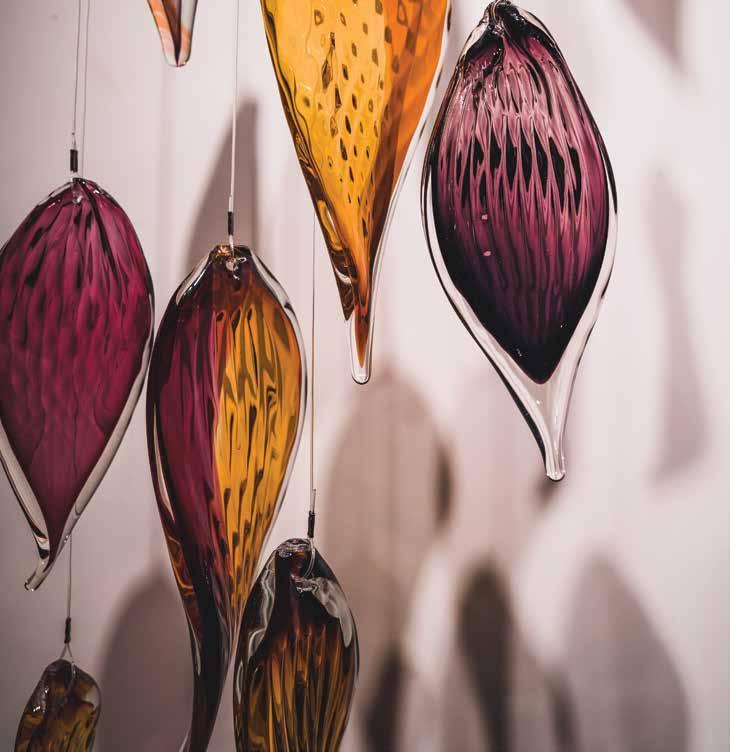
Falling Leaves (detail) 2022
hot blown
sculpted glass
200 × 100 × 150
image: Jack Constantine
Glass artist Gerry Reilly captures the light within glass and the reflections it makes in situ to create objects and installations inspired by travels through vast Australian landscapes or the colours of nature. Landscape, sea and sky ignite his imagination. Process drives his ingenuity. From conception to creation, in a continual process of experimentation, he manipulates hot glass and then sculpts the molten forms into shape.
In recent times, I’ve been commissioned to create custom architectural lighting and sculptural installations. ‘Falling Leaves’ reflects playing freely with some of these ideas: watching leaves twist and dance in the wind as they fall to the ground, catching and reflecting light, glistening with oils, their changing palette of colours as they decompose. GR
Gerry Reilly’s obsession with glass began in the 1980s. Following studies in glass and ceramics at Monash and the University of Tasmania (1976–1981), he helped pioneer the studio glass movement in the South West of WA. He has an extensive exhibition record and creates work on commission. His work is represented in numerous collections, including the City of Bunbury and Ebeltoft Glass Museum, Denmark. Existing catalogues show his history with the Survey dates back to 1988.
Paul Reynolds’ social and political commentaries – or observations of a behaviourist, as he likes to call them – revisit formative moments in his life. Merging humour with a hint of cynicism, he explores the effect life and locations have had on the construction and reinforcement of his beliefs, values and social misgivings. Rendering his subject with an air of self-importance to echo their conflicted state of mind, he chronicles a moment of self-reflection in a space that leaves room for an alternative story.
It seems inevitable that there will be times in our life when our passion and enthusiasm feels lost. I wanted to acknowledge these lacklustre times but with a sense of grandiosity, beauty and reverence. PR
Paul Reynolds (born Luton, UK) studied at Claremont School of Art before receiving a BA in Design and Illustration (Curtin 1990). He also completed a Grad Dip Education (Edith Cowan 1999) and Grad Cert Arts and Entertainment Management (Deakin 2010). Throughout his studies and teaching career, Reynolds has exhibited regularly, including many Surveys since 2006. His work is represented in corporate and private collections.
My heart is just not in it 2021 pencil on plywood, gold leaf 120 × 43
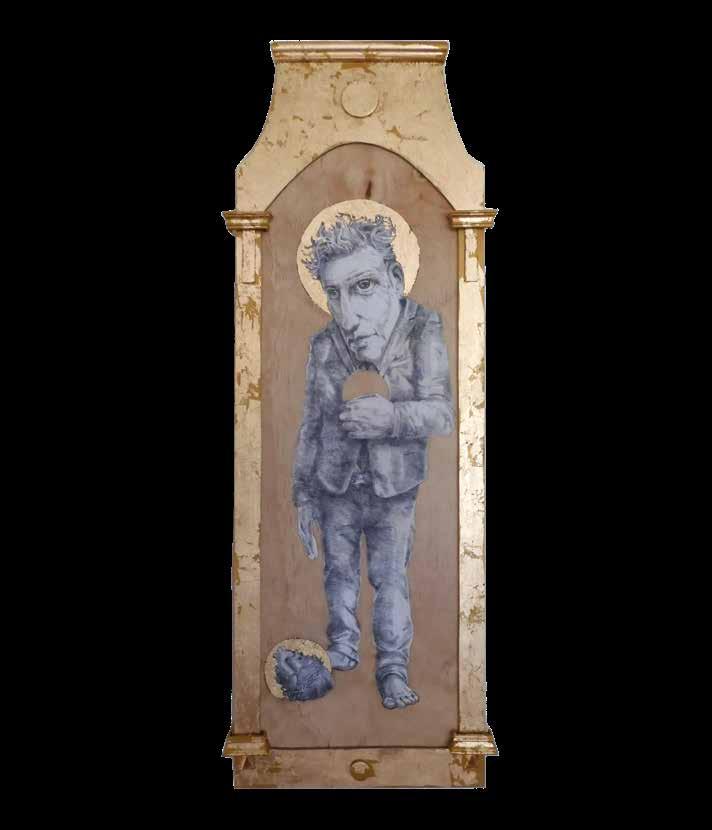
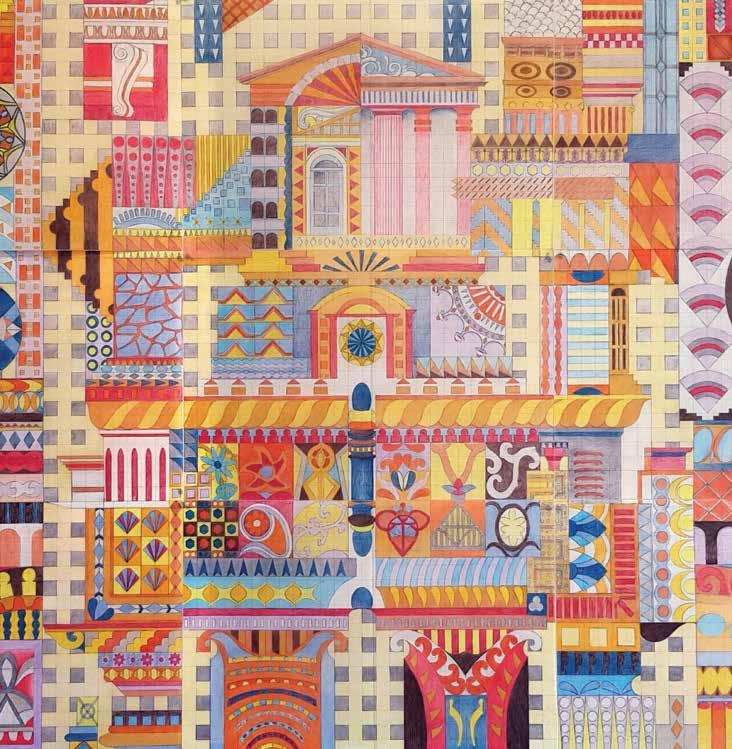
Helena Sahm’s current work revolves around concepts about the built environment. Under the broad theme ‘Living Here Not There’ she has explored architectural styles, housing, disasters that befall buildings and city development. This theme sets the prism on which Sahm sees the world from her home in Bunbury.
Embodiment of a City explores the architectural features that embody Bunbury’s buildings. Sahm plays with the positive and negative shapes and patterns on the buildings’ façades, the range of architectural styles, details and structures, placing them in a semblance of symmetry set in compositions derived from Palladio’s Four Books of Architecture. The overall pattern resembles an enveloping patchwork quilt.
We make decisions about how our business, beliefs, governments, or families present to the world through the façades of our buildings. In architecture, the façade is one of the building’s most important exterior elements. The façade sets expectations and defines the feel of the overall building. Yet most of the time we don’t take much notice of our buildings. HS
Embodiment
Helena Sahm’s practice is eclectic, traversing materials, techniques and expressive forms in an approach shaped by many years of teaching visual arts at secondary and tertiary level. Born in Sydney, she moved to Bunbury in 2002. She has exhibited many times in NSW and WA, including the Survey/South West Art Now on several occasions. She has sat on many arts boards and now works full-time on her practice.

There are two major influences on Stephen Schulyta’s art practice: the natural world and contemporary socio-political issues. These translate into two distinct styles of painting: hyper-realistic seascapes and landscapes inspired by the South West coast and WA’s outback; alongside sit works infused with social commentary and dark political satire.
‘Jokerocracy’ is a parody of world leaders who have claimed ‘only they can fix it’. Full of symbols and codes, the painting remind us of their time in the continuum. It’s inspired by Diego Velázquez’s painting known colloquially as ‘The Buffoon Redbeard’ and by my research into contemporary politics as viewed from Australia. SS
Following a career in mining and mineral exploration, Stephen Schulyta picked up his pencils and paint brushes in the late 1990s as part of his rehabilitation from a serious accident. He has been painting prolifically ever since and participated in four previous Surveys (2010, 2011, 2012, 2018). He lives and paints in Busselton.




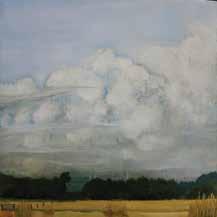

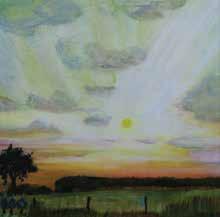


For a decade, Karen Seaman has travelled between her rural property and Dunsborough for work. She finds the drive meditative; it allows her to prepare for and recover from a busy work life. Driving through flat farmland and wetlands, often at dusk, she observes the seasonal changes. The Space Between Worlds is a series of small paintings, one for each month of the year, that aims to capture the atmospheric light in the landscape, the vastness of the sky, and pose questions about land use, weather patterns and our ecological footprint.
The atmosphere separates and insulates our planet from the rest of the universe. Whatever we do is contained in this bubble of gas. It’s a constant source of interest, watching the skies respond to light, air movement, moisture and pollutants. Sometimes skies are threatening, sometimes soothing, but always a reminder of the magnificence of this small blue planet we inhabit. The bell jars paired with these paintings look at small native animals and plants that we so often overlook. They reflect the six rotational seasons of the Wardandi Noongar people who note seasonal change by observation of environment, not a set of dates. KS
Since graduating with a Diploma in Teaching majoring in Art (1985) and a BA Visual Arts from Canberra School of Art in 1988, Karen Seaman has maintained her studio practice alongside her career in primary school art education. She is a regular participant in Margaret River Region Open Studios and exhibits often. She first took part in the Survey in 1991 and was overall winner in 1993.
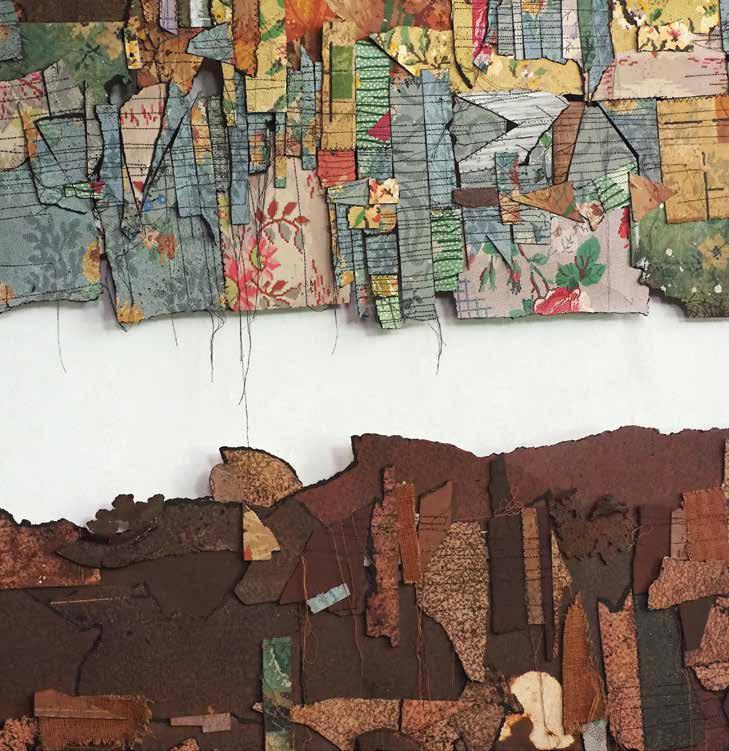
The Poetics of Memory (detail)
2021–22 found lino flooring, cotton thread, found metal and timber diptych, each panel 56 × 350
Helen Seiver’s practice explores personal narratives. Through sculpture, painting and installation she talks about things that really matter to her; be they environmental, political or intensely personal issues. Using a variety of materials and found objects, her work often involves long, laborious and repetitive processes which allow time to reflect deeply on her concerns.
I see lino scraps as poetry. These colourful patterns speak to a life lived. They express a rhythmic unfolding of childhood memory, of bedrooms and kitchens, and the special rooms of the home, of celebration and family time with relatives. Such positive childhood memories. The reverse of those scraps, the underneath, the hidden side reveals the converse of that happy memory. They express the tremendous upheaval and grief of family tragedy. They are the colours of the Pilbara landscape. There is a need in me to stitch these poems, to patch and mend, and to heal the wound and the land. HS
Helen Seiver lives and works in Capel. She has a BA Visual Arts Hons (ECU 2000) and Post Grad Certificate in Australian Indigenous Studies (Curtin 2001). Her exhibition record is extensive and her work is held in many collections. She has exhibited in the Survey/South West Art Now multiple times since 1992, winning Worsley Alumina Award for Excellence (2000), Overall Winner (2001), People’s Choice (2014) and City of Bunbury Acquisitive Award (2016).
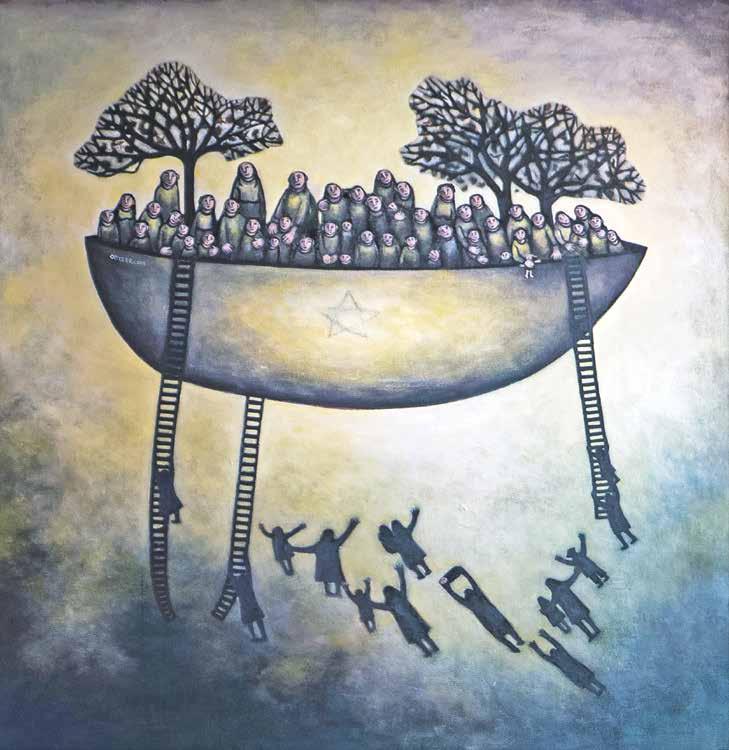
Immaculate Deceptions
(detail) 2022
oil and wax
on canvas
244 × 122
image: Geoffrey Baldwin
Linda Skrolys’ practice is entwined with her family history. Her paintings are psychological narratives full of symbolism that often relates to tales of identity and dislocation. Her Lithuanian father, forced to flee during the Soviet invasion, met her German mother during the turmoil of the Second World War and they left Europe with one small suitcase. Recent works couple this history with current concerns about the challenges and conflicts facing the world today.
The life of an artist can be rewarding. We are mirrors to culture and society. It’s incumbent on us to shine a light on what we see. My work has always been about belonging and family. Empathy is the single most humanising characteristic of humans. The past two years has seen a great shift in the human spirit, reminiscent of stories my Mum told me about living in Germany during the war; propaganda on state-sanctioned radio, watching neighbours disappear, terrified the latest boyfriend might report their anti-Nazi sentiment, living in fear of transportation. Everyone driven by fear and hate of ‘the other’. A divided people will never overthrow an authoritarian government. Empires rise when they benefit everybody. LS
Linda Skrolys was born in Merredin and moved to Esperance during her childhood. She completed studies in Visual Arts (1992) and Art Education (1994) at Edith Cowan University. She first exhibited in the Survey in 1994 and many more times until 2008. Her work is represented in City of Bunbury collection. She lives in Dardanup with family and often exhibits with her husband Russell Sheridan in their studio gallery.
Elmari Steyn is a printmaker and jeweller whose work reflects her love of nature and wilderness. She regards printmaking as a state of being; stories and fragments of memories that begin on bare metal.
‘Tree House at Land’s End’ tells the story of a wild soul who reached a small lake at the start of the desert after an endless journey through untouched woodland. Here he said he would remain and a small house was built in a young tree. The tree grew high and took the house and man aloft to live among the birds. It’s part of a body of story-songs; called songs for the reason that remembrances were oft told, with favourite refrains repeated in a lilting hum by those who recalled these events. ES
Elmari Steyn was born in Namibia where her early career was in fashion design and jewellery. She moved to Australia in 2012 and now lives and works in the southern forests region. She has participated in numerous exhibitions, including the Australian Print Triennial, Mildura Victoria (2018) and the Fremantle Print Award (2021). She is a member of the Printmakers Association of WA.
× 130
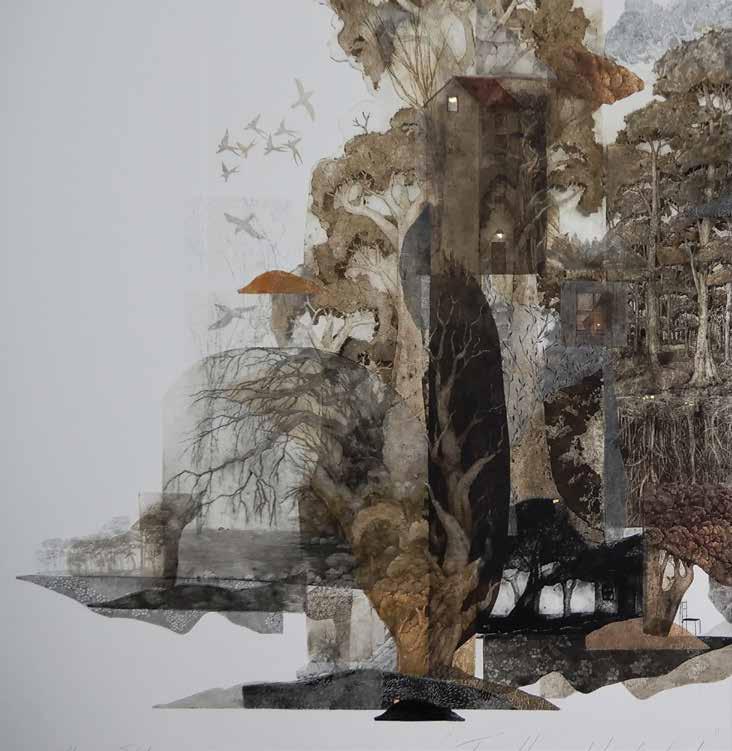
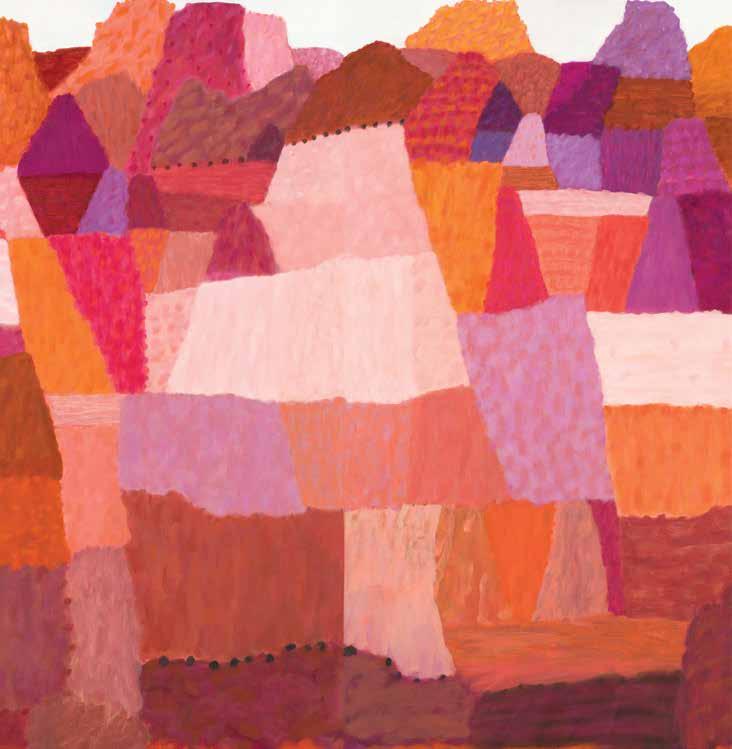
Jewelled Ranges
Northern Territory (detail) 2022
oil on canvas diptych, 100 × 200
image: Nathan Wills
Mary-Lynne Stratton’s paintings are interpretations of the northern landscapes of WA, Northern Territory and Central Australia. Painting en plein air in gouache in remote areas, she challenges herself to look at the landscape in new ways. Layering and uncertainty are part of her process, to allow surprises of colour and form to evolve in a celebration of an exciting landscape.
Being immersed and walking through these ancient landscapes of molten rock formations which have evolved over millions of years provides a sense of belonging and connectedness to something bigger than myself. I am in awe of these places. The random tilting and folding rocks with their jewel-like qualities glistening in the morning and evening light feeds my imagination. Back in the studio these forms are reimagined. They become a playful framework to interpret in colour and reverence. I’m open to the possibilities of what the work can become. Never quite knowing what the outcome will be, I allow the painting to evolve slowly, drawing on the memory of the emotions felt in a particular place, allowing surprise associations of colour and form to lead the eye around and through the painting. MLS
Mary-Lynne Stratton (born Bairnsdale, Victoria) has lived in the Yallingup hills for many years. She has a Bachelor of Arts from Edith Cowan University (2004), has participated in many exhibition and won several prestigious awards including overall winner Cossack Art Award (2016) and Collie Art Prize (2020). Her work is represented in several collections including the City of Bunbury. She took part in numerous Surveys between 1993 and 2013.
On the Brink IV combines recycled, found and natural objects to create a work that ‘buoys’ on its own fragility. Louise Tasker’s aim was to make a statement about the past and a suggestion about how to remake in the present, in the interests of the future.
Recycled objects come loaded with meaning. Found objects carry the history of being something else. I found these sea urchins between the Capes, collected from the thousands washed up from a mass extinction. Were we (people) responsible? Maybe a passing ship cleaning its ballast tanks? Too many different sizes for a natural cycle. Climate change? As hollow containers of what can only be sensed not seen, they are threaded and cushioned on braided computer wire – reincarnating them as a continuum of bouncing ideas supported on a communication mechanism. Strangely, they are also coming to represent an isolation, from nature and from each other, in this digital and COVID-19 world. Are we the next big mass extinction? COVID-19 is a reminder that we are part of the environment. Climate change can’t be tackled by one nation. It must be a united approach. Question is: Who will wear the BIG issues? LT

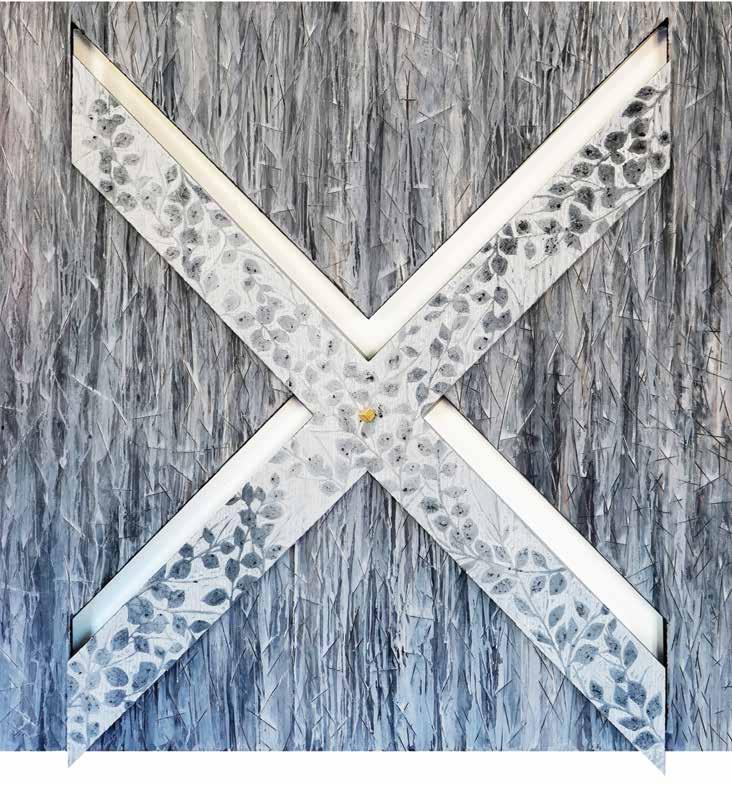
Monique Tippett is driven by an impassioned desire to protect the forest habitat from the ravages of mining, logging and introduced species. Her practice reflects her profound feelings about its natural and cultural value.
‘Landscape amnesia’ is a process by which significant change is considered normal or acceptable if it happens gradually in small increments. It’s also called ‘creeping normality’. I was shocked to learn that the south west of WA is already one of the most climate change affected regions in the world. The gradual reduction in rainfall over the last forty years is a shocking statistic. Most people barely notice that forest streams which would run all year round, and were full of life, are now only winter creeks in a good year, or have stopped running entirely. Forests are rainmakers. Why, in this unfolding climate emergency, do we allow foreign mining giants to cut them down to access minerals? Mining, climate change, pest and disease – a slow torturous demise for our beloved forests. The cross is a recurring symbol in my work. It signifies a marker where treasure is found, the treasure of biodiversity. It also evokes a warning: keep out, keep away and do not touch this place. MT
Monique Tippett lives and works in Dwellingup. For over twenty years she has worked with wood in a restricted palette to emphasise its features and reflect seasonal colour variations. A prolific career spanning two decades includes numerous exhibitions, commissions and awards, including winning the Survey/South West Art Now in 2013 and 2018. Her work is represented in many collections collections including the City of Bunbury, and somehow she finds time to run Lost Eden Creative.
James Walker’s paintings reflect his strong associations with Tasmania and his idea of place when conjuring memories. Seeking the Familiar expresses his sense of re-adjustment to an unfamiliar place; an expansive landscape and cloud-filled sky open to interpretation and discovery, and symbolic of emptiness and yearning.
Living in Launceston Tasmania is a different experience to life in Mandurah. No hills to speak of. No streets describing architecture from the 19th century to present day. No fog. No aircraft passing overhead, and no markers of age. Launceston is a little tired and gritty, but the suburbs of Mandurah feel lived on rather than lived in. Heading south and everything changes. The familiar starts to appear and those indicators of home present themselves. A landscape both undulating and flat allowing it to be experienced from above, below and within. It evokes memories, feelings of loss and a pull towards normality while inviting exploration. Tasmania is home as is Western Australia and both offer a different experience, but there are moments of overlap. It’s within this overlap a moment can be experienced for the sake of itself rather than what’s missing. JW
James Walker (born Launceston) has lived in Mandurah since 2018. He completed a Bachelor of Contemporary Art (2009) and Master of Teaching (2011) at the University of Tasmania and taught art at Launceston Church Grammar School prior to leaving Tasmania, whilst pursuing his own practice. He has an extensive exhibition records, including selection for the Heysen Prize for Landscape (2016) and Glover Prize eight times between 2012 and 2022.
Seeking the Familiar (detail) 2022 oil on canvas triptych, 60 × 135
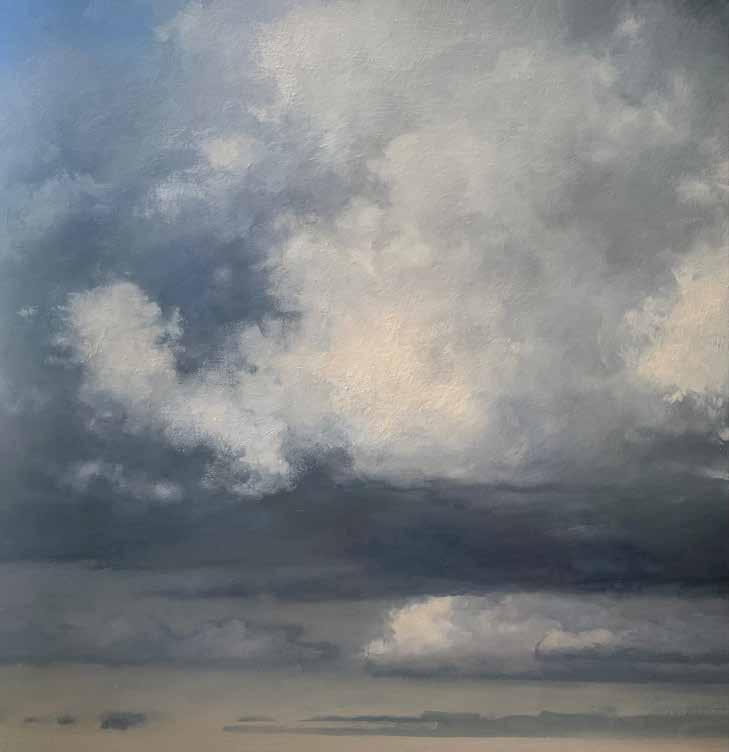
Jo Wassell’s practice looks at her immediate environment. Shifting between people, places and memories, she creates personal introspective works that tell her own and other individual’s stories. The possibilities of drawing underpins her practice, and she explores its range from instinctive mark-making to detailed studies.
‘Elevate the quiet ones’ is about promoting the unseen; showcasing the overlooked, celebrating those who move quietly through this world. This drawing was inspired by a piece of dead foliage I found when walking through bushland on Mount Clarence near my home in Albany. Six centimetres in length, it was easy to overlook; to me it was beautiful. The foliage is different front and back, hence the diptych shows off both sides. I rendered it in graphite to celebrate the understated beauty of this medium, and although it’s not an exact replica of the subject, the drawing honours the splendour of this tiny piece of nature. JW
Jo Wassell (born Solihull, UK) has live in Albany since 2017. She completed a BA Hons in Drama (Loughborough 1993) and Diploma in Community and Youth Studies (Birmingham 1997) and worked as a youth worker before arriving in Australia in 2003. She now works full-time for an organisation that supports people with disabilities, whilst pursuing and developing her arts practice.
Elevate the quiet ones (detail) 2022 graphite and carbon on Fabriano paper diptych, each panel 76 × 56
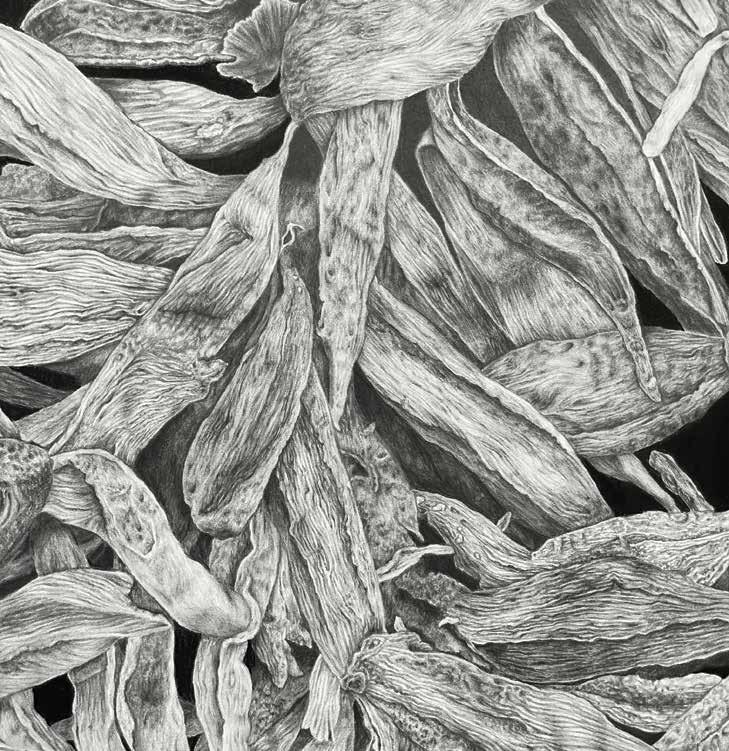

Convoy 2022 found objects, recycled timber, pigments, vintage furniture castors dimensions variable, maximum height 59
The disparate materials Chris Williamson uses in his practice can be described as mechanical/ industrial/electrical and usually exhibit the patina of age and neglect. His intent is to create forms that have a substantial presence, carry a strong narrative and hide a quietly subversive or anarchic subtext. Collecting old materials and objects that show a possibility of working again has been a lifelong passion for Williamson. In recent years, he has coupled that passion with the opportunity to repurpose old objects to tell ambiguous new stories. Do these vessels pose a threat? Where are they from? What might they carry? And who let them in?
Our collective experience in the South West since COVID-19, almost hermetically sealed off from the rest of the world, might offer a breeding ground for anxiety, fear and a suspicion of ‘others’ arriving from ‘elsewhere’. ‘Convoy’ asks us to consider our responses to these issues, whilst hopefully enjoying the peculiar pleasures and seductive textures afforded by the machine aesthetic. CW
Chris Williamson (born Sheffield, UK) studied commercial design and worked in advertising for many years before moving to Australia in 1982. Following a long career in graphic design, tertiary education and community arts, in 2009 he decided to focus on his own practice. He exhibits regularly in WA and his work is represented in many collections in Australia and overseas, including the City of Bunbury. Existing catalogues show his history with the Survey dates back to 1988.
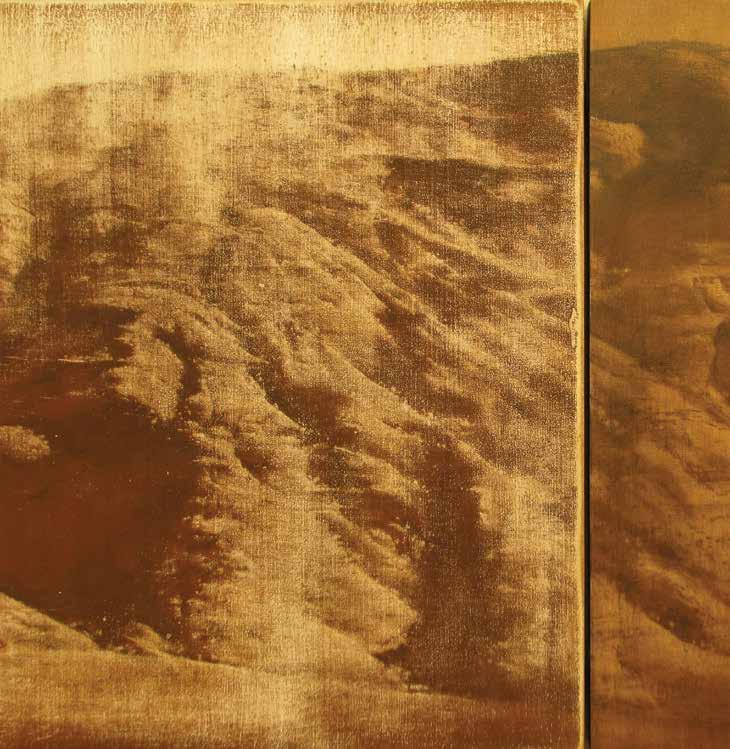
Earthbound II (detail) 2022 earth pigments, conte crayon, oil paint triptych, each panel 41 × 51
Tony Windberg’s Earthbound II depicts ranges in WA’s Pilbara region close to major iron ore mines. The work arose from sacrificial and symbolic destructive processes. In 2020 the obliteration of the Juukan Gorge archaeological sites illuminated a prioritisation of values: landscape stripped back to bare rock demonstrating importance of resources extraction over the protection of culture. Windberg’s use of earth pigments and reductionism is characteristic of his approach to materials and processes that signify a figurative link with the subject.
The levelled and barren earth lay bare both the nature of humanity and its vulnerability. Such acts remind us that these adventures and misadventures take place on the delicate living skin of an otherwise dead planet. It’s upon this familiar surface covering the outermost rocky shell of the lithosphere that the richness of anthropological achievements plays out, at the tail end of a far longer history of life on earth. Our capacity to respond with feeling to the world around us, to wonder with awe and decry its destruction, is extraordinary and profound by its very existence. To project these values onto an uncaring universe, onto neutral geology, to add value, vernacular, embellishment, culture and art turns rocks and ranges into something higher. TW
Since graduating with a BA Fine (Curtin 1986) Tony Windberg (born Melbourne) has worked full-time in his practice. His career embraces an extensive exhibition record in WA and interstate, several commissions and numerous awards, including the Worsley Alumina Award for Excellence (2006), Overall Winner (2011, 2013) and Packer’s Prize (2020) at the Survey/South West Art Now. His work is represented in many collections including the City of Bunbury.
Isolation is a recurring theme in Christopher Young’s photography practice. The remoteness of growing up in semi-rural New Zealand, the loneliness of living in Germany with poor language skills, and the geographic and ideological seclusion of life in regional Australia have all coloured his narratives. Nine #02/#03 is part of a larger series called Nine where Young will explore the pressures of inn-keeping and the random stories that accumulate from that experience.
In 1984 my parents decided to take up the lease of a motel on the outskirts of a small village. In the early days they were very much dependent on heavy industry, including an oil refinery that was under construction and a local dairy factory. Once construction of the refinery was completed, bookings dropped off considerably. Mortgage interest rates rose and my parents had to take on extra jobs. Due to these pressures, me and my younger brother both worked in the motel, cleaning rooms, interacting with guests, serving food. While this phase of my life was extraordinarily stressful, it exposed me to the outside world and people with fascinating lives. CY
Christopher Young (born New Zealand) lives in Margaret River. After finishing a Diploma in Applied Arts at Northtec, Whangarei (1994) he moved to Germany in 1996, then settled in WA in 2002. He has exhibited in NZ, Germany, WA, VIC, NSW and QLD, is on the board of Arts Margaret River, and his work is represented in many collections, including the City of Bunbury. This is his third appearance in South West Art Now since 2018 and 2020.
Nine #02/#03 (detail) 2022
LightJet prints diptych, each panel
×
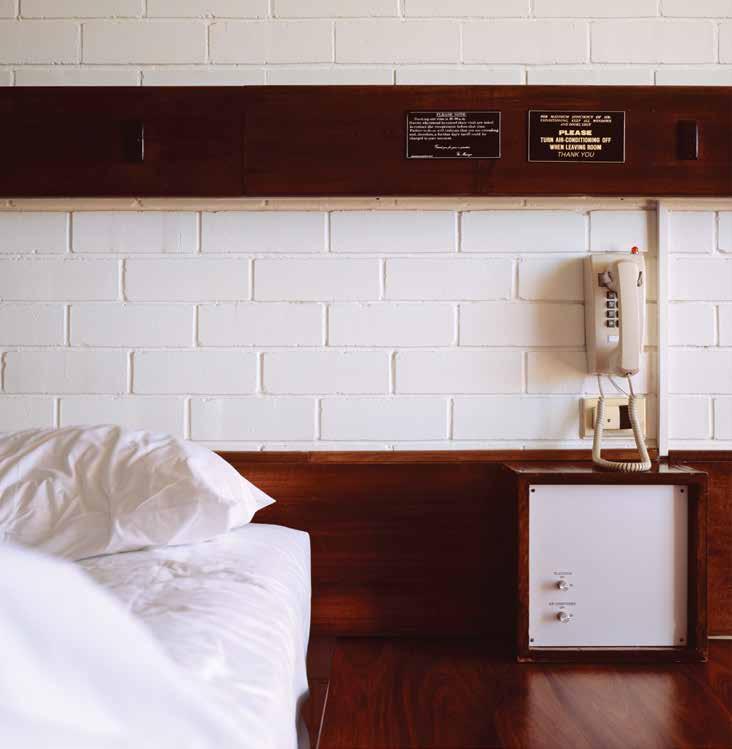
Amanda Bell
Kedalak (Night): Oh, someone’s coming to get me 2022
clay, marri gum, teabags and stones
various dimensions
image: Julian Bowron
Sam Broadhurst
Silence of the Moment 2022
bodied walnut oil on Belgian linen
112 × 132
Rachel Coad
The everything you don’t see, self-portrait 2022 oil on linen
63 × 83
Sue Codee
Morning Walk 2022
ink on paper on canvas
90 × 90
Rebecca Corps
The Divine Within 2022
tempura and gold leaf on marri
150 × 25
Molly Coy
Pretty Plagues 2022
artist book: acrylic paint, ink, mono-printed archival tissue, frottage, colour and gold foils
circa 62 × 450 × 59
image: Alan Coy
Jo Darvall
Boranup Forest 2022
watercolour monoprint on Arches
BFK with pastel and pencil
triptych, each panel 96 × 73
image: Miles Noel
Annette Davis
A Walk on the Hill 2022 found sticks, eco-dyed cloth and cotton string, woollen blanket, thread
70 × 160
Merle Topsi Davis
Beached, Bleached and Leached 2022 steel, plastic, fishing debris and beachcombing finds
200 × 150
Tony Davis
Mantle (Encapsulated) 2021–22
jarrah and steel
204 × 58 × 56
Joshua de Gruchy
Separateness 2021 synthetic polymer and pumice grains on polycotton canvas
200 × 200
Sue Dennis
Saed : Seed 2022
artist book: handmade paper, watercolour and ink drawing, monoprint, frottage
circa 5 × 35 × 35
Jenni Doherty
Glimmer of Hope 2022 oil on canvas
diptych, 122 × 122
Elizabeth Edmonds
Moving through Peaty Lowlands 2022
original ink drawings printed on suspended and layered chiffon
200 × 280 × 100
Ian Dowling
Transition 2022
high-fired stoneware with copper and iron
triptych, 25 × 69 × 16,
20 × 72 × 13, 23 × 77 × 16
Robert Ewing
Coastal Landscape 2021
acrylic on Belgian linen
101 × 93
Galliano Fardin
Surge 2021 oil on canvas
113 × 153
Andrew Frazer
From Places I Used to Know 2022
acrylic on canvas
157 × 106
Richard Fry
Memorial, parts I and II 2019-2022
I: correction fluid and pencil on recycled silk
260 × 160
II: wood, glass, ceramic, saltwater and sand
151 × 57 × 57
Kay Gibson
Timeless Treasure 2022
handpainted and printed collage on paper on canvas
130 × 210
Ruth Halbert
Turn 2022
handwoven linen thread
100 × 120
Catherine Higham
Radii 2022
encaustic painting
79 × 79
Peter Hill
Concept house and the bands of time 2022
acrylic and oil in timber
(pine, marri and jarrah)
166 × 204 × 20
Val Hornibrook
Topography of Water Courses 2022
wet and dry felt-making with merino wool fibres and cotton yarn
155 × 90
Deborah James
Quattuor Equos Apocalypseos
Australia: Bushfire, Storm, Drought, Extinction 2022
raku fired stoneware
26 × 26 × 10 each
image: Julian Bowron
Davina Jogi and Victoria Baker
The Defenders 2020–2021
documentary installation comprising: The Defenders multimedia film, 7.25 minutes
Reading the Map, Yornup Mop-up, Steven Schrama, Pete and Lyn Whitney and Dusty, Colin ‘Wombat’ Grant photographs on fine art paper
42 × 59.4 each
image permissions: Shire of Bridgetown-Greenbushes Volunteer
Bushfire Brigade members
Peter Kovacsy
Sanctuary 2022
cast glass
72 × 27 × 9
Carly Le Cerf
Geological Timescale 2022
encaustic and oil on board
diptych, 120 × 222
image: Wayne Harrington
Alice Linford Forte
Silver Linings 2022
oil on canvas
143 × 143
Elisa Markes-Young
Spaces Between 2022
Wenzhou paper, thread, sequins dimensions variable
Lesley Meaney
Land of the Rainbow Gold 2022
acrylic and thread on canvas
diptych, 52 × 390
Paul Moncrieff
Your Move 2022
acrylic on assembled plywood panels
35 × 210 × 150
Steve Pease
Relic I, Relic II 2022
fold formed copper vessel with heat application of patina
30 × 10 × 10, 20 × 9 × 7
image: Fran Jackson
Lori Pensini
We of the Wandoo 2021
oil on linen
130 × 100
image permission: Gloria Lockyer
Martine Perret and Vivian
Brockman Webb (Dwardinan)
Mitchee Youp Bullargar
(Coming Together) 2020–21
multimedia installation comprising:
Mitchee Youp Bullargar (Coming Together)
project production, photography, video, sound: Martine Perret
music composition, video
editor: Jonathan Mustard
voices: Vivian Brockman
Webb, Mitchella Hutchins and Mabenan Hutchins
drone: David Dare Parker and Martine Perret
8 minutes
Dwardinan
giclée on fine art photographic paper: Martine Perret
100 × 70
Djanga Bora
ceremonial and burial poles carved and varnished/stained wooden totems, headdress with wool, jute, feather, gumnuts, paint, pigment, ochre, commissioned by Martine Perret for Belong, created by Vivian
Brockman Webb and her family
207, 160, 113 height of each pole
Laurie Posa
The Last Supper 2021
oil on canvas
60 × 152
image: Lauren Trickett
Fiona Rafferty
Excavating the Site 2022
pen and ink drawing and printing on Arches paper
9/9 drawings, 192 × 252
6 artist books, dimensions variable
Gerry Reilly
Falling Leaves 2022
hot blown sculpted glass
200 × 100 × 150
image: Jack Constantine
Paul Reynolds
My heart is just not in it 2021 pencil on plywood, gold leaf
120 × 43
Helena Sahm
Embodiment of a City 2022 coloured pencil on architects tracing paper
109 × 166
Stephen Schulyta
Jokerocracy 2022 oil on panel
86 × 65
Karen Seaman
The Space Between Worlds 2022 oil on birch board
12 paintings, 30 × 30 each
6 bell jars, 27 × 14 each
Helen Seiver
The Poetics of Memory 2021–22
found lino flooring, cotton thread, found metal and timber
diptych, each panel 56 × 350
Linda Skrolys
Immaculate Deceptions 2022
oil and wax on canvas
244 × 122
image: Geoffrey Baldwin
Elmari Steyn
Tree House at Land’s End 2022
multi-plate etching on BFK paper with Chine-collé, handcolouring and 23k gold leaf
90 × 130
Mary-Lynne Stratton
Jewelled Ranges Northern
Territory 2022 oil on canvas
diptych, 100 × 200 image: Nathan Wills
Louise Tasker
On the Brink IV 2022
sea urchins, co-axial cable, fishing line, sterling silver 530 × 6 × 5
Monique Tippett
A Thousand Cuts 2022
jarrah, charcoal, inks and gold leaf
143 × 138 × 10
James Walker
Seeking the Familiar 2022 oil on canvas
triptych, 60 × 135
Chris Williamson
Convoy 2022
found objects, recycled timber, pigments, vintage furniture castors dimensions variable, maximum height 59
Tony Windberg
Earthbound II 2022
earth pigments, conte crayon, oil paint
triptych, each panel 41 × 51
Jo Wassell
Elevate the quiet ones 2022
graphite and carbon on Fabriano paper
diptych, each panel 76 × 56
Christopher Young
Nine #2/#3 2022
LightJet prints
diptych, each panel 64 × 80
Bunbury Regional Art Gallery Team
Michael Bianco Director BRAG
Anna Edmundson
Administration and Operations Coordinator
Caroline Lunel
Collections Curator/Registrar
Simon Long
Exhibitions Officer
Karen Morgan Noongar Arts Officer
Paula Thompson Marketing Officer
TBC Education Officer
Sheree Dohnt Customer Service Gallery Officer
TBC Gallery Officer
Katelyn Whitehurst, Josef Quinn, Claudia Stiglmayer, Dan Kus
Gallery Attendants
Bunbury Regional Art Gallery is owned and managed by the City of Bunbury
Award Judges
Prof Susanna Castleden
Jim Cathcart
Government Partner
Department of Local Government, Sport and Cultural Industries
South West Art Now 2022
Sponsors and Supporters
City of Bunbury
Vukelic Group
Bunbury Geographe Chamber of Commerce and Industry
Geographe Wine Association
RunAmok Cider Co. Jacksons
This publication is proudly printed and supported by The Print Shop Bunbury.
First published in 2022 by Bunbury Regional Art Gallery
64 Wittenoom Street
Bunbury WA 6230
Australia
www.brag.org.au
This publication is copyright and all rights are reserved. Apart from any use as permitted under the Copyright Act 1968, no part may be reproduced or communicated to the public by any process without prior written permission. Enquiries should be directed to the publisher.
© Bunbury Regional Art Gallery 2022
Published in conjunction with the exhibition
South West Art Now 2022, an exhibition curated by Dr Diana McGirr and held at Bunbury Regional Art Gallery, 64 Wittenoom Street, Bunbury, March 26 – May 15, 2022.
A catalogue record for this book is available from the National Library of Australia.
Title: South West Art Now 2022
ISBN: 978-0-9953569-9-3
Author and Editor: Dr Diana McGirr
Foreword: Anna Edmundson
Designer: Christopher Young
Photographer: All images courtesy of the artists unless otherwise noted.
© Catalogue essay: Dr Diana McGirr
All measurements are in centimetres unless otherwise noted.
Please note that indicative images of artists’ works have been included in this publication in instances where the work for the exhibition was not final at the time of printing.
This publication contains the names and images of Indigenous people who may have passed away.
Cover
Molly Coy
Pretty Plagues (detail) 2022
artist book: acrylic paint, ink, mono-printed archival tissues, frottage, coloured and gold foils
circa 62 × 450 × 50
image: Alan Coy



